#a brief one-off villain for a small arc of his relevence
Explore tagged Tumblr posts
Text
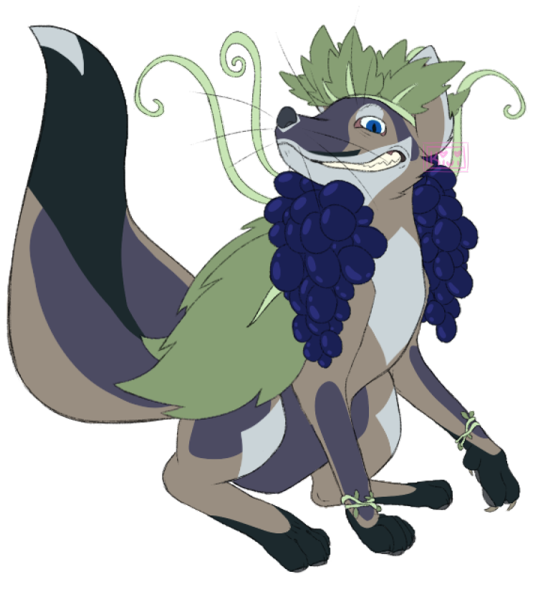
Common descriptors of foxes may include cunning, clever, and tricky. And all would be true for the impeccably intelligent mister Vin Dictive!
Vin believes himself the epitome of knowledgeable when it comes to his kind. A clever specimen as he is, adorning such advanced abilities not many normal animal-kind bare like speaking aloud, he finds himself a high and mighty monarch ruling over wherever he treads. Of course, following behind his tail is a line of trickery. Vin likes to make others react to his crimes, and they usually will. This fox seems to have grown far too comfortable slipping away from the consequences of his actions.
Being such a selfish and careless creature with a knack for fooling the less fortunate has landed himself a pretty hefty bounty for his head. It’s apparently held up by a certain pair of ruthless twins. And those twin bounty hunters who seem so keen on his defeat… oh, how he despises them so! Wearing his own subjects like intimidation tactics! How fickle, and how rude! Whoever would place such a resilient bounty for his execution!? But he knows he’s always bound not to let himself be bound. After all, he’s no ordinary fox like any other he’s called upon before. He’s a gray fox— one complete with a feature not many other canines have: retractable claws, perfect for things like climbing and scampering away, or even more casual things like scaling trees to collect fruits where the usual, lesser canine could only dream to reach.
And to display such impressive divinity and vanity, Vin wears his cape, headdress, and bracelets of leaves, vines, and grapes with pride. He doesn’t even have to tend to them or replace them! Because… well, they’re not real grapes along him. Just his own craft to give off a kingly approach. But he won’t tell you that. It’s possible that the falsified nature of his inauthentic gear could allude to the devious demeanor of this divine deviant. And recently, he’s heard from the grapevine that there’s a strange newcomer woman in his neck of the woods… a perfectly pathetic candidate for action in his eyes.
But don’t quote him on that… it’s only a little birdie that told him.
———
Several weeks ago, me and my friends had an unexpected “character creation convention” that revolved around the possibility of a potential fox character, who would then take major inspiration from The Fox and the Grapes. Admittedly, I’ve slipped in just a little bit of Evil Queen (from Snow White) inspiration in there as well.
Vin’s name is also interesting as well; taking from the term “Vin”, which means wine, “Dictator”, as he’s a rather headstrong guy who sees himself as a feared leader, and “Vindictive”, which means to have an unreasonable desire for revenge.
Though there’s a bit to unpack about Vin, I should also note that he’s planned more as a side character with his own brief moment of plot. In terms of the whole story, he’s not the most important character, but will certainly have his importance when it’s his time to shine :)
Credit to @aggresively-doesnt-know, @vinesoy, @menthum-mint, @pazam, @shroingushour, @pizzabits, @agent-plaguemask, and @barnowlblu for helping a lot with the original idea and design concepts of Vin! Whew that is a lot of people! I hope I didn’t forget anyone! Sincerely hope y’all don’t mind that!
#WAKE UP SLEEPYHEADS#NEW DUCK DUCK GOOSE CHARACTER REVEAL#not much else to say that I didn’t already say in the post but#he sucks major dookie fart#he’s certainly a villain but like. a side villain#a brief one-off villain for a small arc of his relevence#so don’t get too excited about him tbh#on episode 9 of I hate drawing dogs :3 (HELP)#I should probably still polish his ref like#it’s kinda messy right now. I’ll eventually get to it though#Vin Dictive#Duck Duck Goose#ocs#original characters#original stories#character references#character design#The Kiwi Draws
5 notes
·
View notes
Note
I’m sending you a million prompts! #24 teasing for Frostironstrange! 💚❤️💙 Thanks!
No problem! I've having fun writing all these small pieces! Thank you so much for the prompt!
~~~~
Tony threw his pen down onto the table, making it clatter as loudly as he could to show his annoyance. Fury ignored it, fixing him with an unimpressed stare before turning back to his holographic presentation. He hated meetings, did anything he could to avoid them. SHIELD briefings, Avenger meetings, hours of listening to Stark Industry shareholders, he dodged them all.
Anything. He’d rather be doing anything else.
Alright, that wasn’t strictly true, Tony had no problems with the Avenger briefings, or their informal troubleshooting meetings where they discussed how they were going to deal with future villains. Tony’s favorite meetings, the ones he never missed, were about the new recruits they were teaching. Something had been unearthed in Tony ever since he’d been mentoring Peter, a nurturing advisor side that he’d never been aware of.
That was what Fury had lured him here with, the promise that they’d highlighted some interesting individuals to bring into the fold. As soon as Tony had pushed his way through the glassy black doors of the conference room, spotting Stephen sitting on one of the pristine leather office chairs, Tony had tried to back out of the room, stopping only when Stephen hissed out his name.
Making his displeasure known with every plodding footstep, Tony had thrown himself into a chair opposite the wizard, slumping over on the huge oval table between them. The only silver lining in this boring bureaucratic meeting was the fact Loki had teleported in part of the way through, apologizing on behalf of Valkyrie and the citizens of New Asgard for his tardiness, pulling out the chair beside Stephen and sitting.
Apart from Stephen’s initial command that Tony stay here, neither of his lovers had acknowledged his presence, both avidly listening to Fury’s monotonous speech about budgets and government legislation. It was all important stuff, Tony wasn’t denying that, but it was Clint’s turn to attend one of these to represent the Avengers.
Tony wondered where he was hiding, and why he hadn’t thought of it first.
Tapping his finger on the table, Tony glanced up at the presentation, biting down the sarcastic comment he had about SHIELD technology and how FRIDAY was far superior, quickly scanning over the relevant information to make sure he understood what was being said.
His gaze flickered over to his lovers again, Loki now stretched back so he could murmur in Stephen’s ear, probably asking for clarification on what was being spoken about. Fury faltered in his speech as he caught Loki whispering, but he said nothing, probably worried he would bring tension to the diplomatic peace they had with the Asgardians.
Tony’s relationship with the other two wasn’t known by many others. Pepper and Rhodey knew, as did Wong, although Tony wasn’t sure he approved after watching him hide himself every time he and Loki spent time at the Sanctum. The only other people who knew were Thor and Valkyrie, who had both been happy for them all, Thor shedding a tear in acknowledgement of his baby brother growing up.
Tony snorted a laugh at that, catching the attention of everyone around the table.
‘Something you wanted to add, Stark?’
‘Nope not me, continue,’ Tony waved obnoxiously, grinning as Fury’s eye twitched.
He chanced a glance towards the other two, but they’d turned their attention back to the presentation, Loki’s teeth biting into his lower lip in concentration, doing nothing to indicate he was in an intimate relationship with the Sorcerer sat beside him. Tony wasn’t ashamed of his partners, and he knew they weren’t of him, but he was firmly of the mind that sometimes the fewer people knew about his life the better.
The media had a way of warping all his intentions, and he didn’t want anything to jeopardize the positive regard humans had towards the Asgardians, nor did he want the Masters of the Mystic Arts to be revealed, and Stephen’s ties to them.
It was unfortunate, Tony wanted to show his partners off to the world, to show how happy he was with them, but the people who mattered knew, and that was enough for him.
Tony felt a slight itch at the back of his neck, and he reached up to scratch it, checking for any loose threads on his shirt collar or stray hairs. Loki’s hair was always getting caught up in his stuff, strands of it caught in his rug, his bed, his shower.
Resting his elbow on the table, he let his eyes go unfocused as he listened to Fury drone on, his mind returning to the project he’d been working on before he’d been summoned. After he’d finished calculating equations in his head, his thoughts turned to the other two sat across from him, wondering if could schedule some sort of date for them.
He hadn’t seen them both in days, bordering on just over a week now.
A tickle ran up the inside of his calf, and he reached down to scratch it, frowning when it continued to tease up his leg towards his knee, feeling suspiciously like a hand. Glancing down beneath the table, Tony couldn’t see anything but his jean-clad legs crossed at the ankle. Suspicious, he glanced over towards Loki, but he was asking Fury a question, his eloquent voice and accent spreading across the room, and Tony could see the effect it was having on the female SHIELD members.
He was such a flirt.
Running his tongue over the back of his teeth, Tony turned his gaze to Stephen who was engrossed in the dialogue between Loki and Fury, his eyes gentle in that specific way of his Tony only ever saw when the wizard was looking at them both.
Not them then.
Writing the whole experience off as an overactive imagination mingling with his intense desire to see them both again, Tony crossed his legs at the knee and leant back in his chair, folding his arms over his chest. He startled as something forcibly wrenched his knees apart, sending him face-first towards the table.
The slap of his palms slamming into the table made several people jump, the woman beside him dropping her pen and notebook onto the floor.
‘Stark!’ Fury barked, banging his own hands down on the table. ‘Interrupt me again and I’ll have you placed on a recon mission in the middle of nowhere!’
‘A bit pointless if there’s nothing there…but noted. Sorry, lost my balance…’ he trailed off, clenching his jaw, refusing to back down, both to Fury and the two playing a prank on him.
Tony was well aware of what the game was, and he was already at a disadvantage, craving their touch because of the time spent away from them, and because he was now powerless to them both. He couldn’t defend himself, there was no physical person to restrain.
The touches caressed his skin with varying pressure, and he knew which was which, could easily pick out the firm, confident touch of Loki, and the trembling, reverent touch of Stephen. Neither of them touched anywhere intimate, but Tony felt himself swaying into the touch, shuddering when he could feel ghostly fingers tease up the side of his neck, clasping gently before they swept up to behind his ears, massaging and then grazing along the shell of them.
He managed to turn his moan into a cough, clenching his hand into a fist and bringing it up to his mouth as he hid his expressions. A weight settled in his lap, and he knew it was Stephen’s. He didn’t need to glance over and see the tiny smirk on his mouth, he knew that Loki, despite his slender form, was far heavier.
‘If anyone doesn’t have any questions?’ Fury brought the meeting to a close, and Tony glared at the two of them across the table, trying to shove all of his emotions into his eyes, hoping they could read his mind and not draw this out any longer.
‘There is something I wish to speak to Stark about concerning the output energy of our arc reactor, but I have no questions for you. I believe you have put your points across well, and I will relay these concerns to our king on your behalf.’ Loki’s voice flowed from him like he was unaware of what his touches had been doing to Tony, like he wasn’t affected by the game he’d been playing.
‘Doctor Strange, can I have a word with you outside for a minute?’ Fury directed at Stephen, his eye darting between the three of them, and Tony wondered if he’d figured it out, if he knew what had been happening during the briefing. Despite his usual ability to hide everything behind a poker face, Tony felt himself grow warm, and he knew he was blushing.
Loki waited until everyone had filed out, not even looking at Stephen as he left to talk with Fury. His eyes were focused on Tony, the vibrant green seeming to glow in the dim room, snatching the breath from his chest as they waited.
He only lingered for a heartbeat after the door had shut and then he teleported across the room into Tony’s lap, his hands mimicking the touch across his neck and ears from earlier and his tongue thrust deep into Tony’s mouth.
‘Are all Midgardian government meetings so tedious?’ Loki panted when he broke away, reaching down to flick his tongue across Tony’s ear, his hands clutching him close, like he too had suffered from the time spent apart.
‘I’ve sat in one of your Asgardian ones, that was far worse,’ Tony gasped, trying to stretch up to get Loki’s mouth back on his, aching for a kiss.
‘Have you missed me, Anthony?’ Loki purred down at him, leaning down so his chest rested on Tony’s, magic holding Tony to the chair as he kept his mouth out of reach.
‘I’ve missed you both.’
‘Always playing favorites,’ Loki scoffed, refusing to let Tony kiss him.
‘The cruel teasing has you written all over it, Lokes,’ Tony grinned.
‘Actually, it was my idea.’ Stephen’s rumbling voice interrupted, the sparks of his portal raining down onto the floor.
‘I hate you both,’ Tony growled.
‘That’s not what you said last week,’ Stephen told him. ‘In fact, why don’t we have a repeat performance, and you can scream how much you hate us.’
Tony gulped, the movement not unnoticed by Loki still perched on him who smirked and leant down to swipe his tongue over Tony’s larynx.
‘Don’t worry, beloved, we’ll replace all those teasing touches with our hands…or mouths,’ he whispered into Tony’s ear. ‘You deserve a reward after listening to all that drivel.’
Tony yelped as a portal opened beneath him, the chair banished away by emerald magic as he collapsed backwards onto Stephen’s bed.
#writing prompt#answered asks#thank you for the ask!#frostironstrange#tony stark#stephen strange#Loki#fanfiction
21 notes
·
View notes
Text
Reaction to RQ!Reverse episodes (Librarian, Nightmare’s Return, Sandwich Boi’s brief moment of glory, Chaos vs Ultra)
First of all.........wow.
...I have many negative feelings about these episodes.
Ok. These episodes.
It’s all RUINED, Can I fix it? Can Chaos Steve be STOPPED? I’ll find out IMPORTANT tips on how to STOP the DARKNESS 1 reason NIGHTMARE STEVE is still ALIVE This is how Nightmare Steve TRICKED me! Mysterious Figure CONFRONTS Nightmare Steve TRAPPING Chaos Steve and STEALING his power! I created ULTRA STEVE, and you won’t believe this but... WOW...Ultra Steve did THIS to Chaos Steve Why would Dark Steve BEG Rainbow Steve for THIS? This Steve actually RETURNED!! NO WAY! The ONLY way to defeat the ULTIMATE Steve in Minecraft How to make a PORTAL to the VOID! Reverse Steve finally LOST IT
14 episodes. 14 episodes total after the Faceless arc to finally deal with Reverse Steve.
Compared to how long the arcs in the Steve Saga are, 14 episodes seems like a short, clean amount of plot advancement.
But while I was bingewatching these episodes, it didn’t feel like 14 episodes of story to me. It felt like....chaos.
The plot in these episodes is really jarring to me because it was doing WAY too much in a SMALL amount of time. And most of the plot was the heroes reacting, rather than being proactive. And I...didn’t like it.
Let me explain:
So, the Steve Saga did a “Villain of the Week” format. Where one (1) villain is introduced and dealt with, and then the next villain is introduced. It was repetitive, but easy to follow.
Examples from the Steve Saga: Dark was a threat. Dealt with. Shadow was a threat. Dealt with. Nightmare was a HUGE threat and Shadow and Dark were added, but it worked because we know who Dark and Shadow are. Dealt with. Then Reverse, then Positive/Negative/Infinity, then Plague, then Faceless, and so on.
Rainbow Quest doesn’t follow that formula. It’s connecting all of its villains into one arc, where one villain is naturally the consequence of another villain.
Rainbow Quest Season 1 mainly set up the villains, the main plot, and a sequel hook. This is unlike the Steve Saga because while the villains just spawned into the story line, Rainbow Quest is showing us the rise of the villains. We know Nightmare’s origins, Dark’s origins, and Reverse’s origins, and they were all spaced out and connected to the main plot (getting the crystals) well.
We had Nightmare as an antagonist, or an obstacle in the main plot (finding the 7 crystals while saving Steves from doom), and his actions created Dark Steve. That worked. And since Rainbow Red was established early in the series and had little cameos before his transformation to Reverse Steve, that helped set up the sequel hook for Season 2. That also worked. imo, the format RQ Season 1 uses is a lot better than TSS’s formula; it’s less repetitive so it feels fresher to long-time viewers, and it connects to the overarching plot well.
But Rainbow Quest S2 didn’t follow the format S1 used.
While Season 1 has a good balance between main plot (finding the crystals) and subplots (setting up villains and future story), Season 2 had WAY too much and an unbalanced amount of subplots. S2′s subplots TOOK OVER the main plot.
What even is the main plot of S2? Well, based on the first episode where we heard Rainbow’s voice, I think the audience was expecting the main plot to be Rainbow Steve saving Steves and adjusting to becoming the new hero and keeping his identity secret to boost morale, while Reverse (later Chaos) will be the main villain.
We were supposed to see Rainbow and Sabre go from color to color to help everyone defend against the Darkness and restore hope.
But then that got hijacked by Reverse, who drained all of Rainbow’s powers and forced him to be saved by the Orange Steves, outing him as being Main Orange reincarnated as the hero.
Rainbow and Sabre haven’t even saved anyone yet at this point. They just went to the Yellow Steves to receive Light’s training and the Orange Steves to see that they’re doing well.
The beginning of the season made a huge deal of keeping Rainbow’s true identity a secret. It was going to be part of his character development about responsibility, bravery, and being someone else. But S2 just did a speedrun of that character arc because he was immediately outed, and the Orange Steves were ok with the truth. So why was there so much stress on Rainbow’s secret when it wasn’t going to impact the plot anyways??
Anyways, then they did their side quest of helping Ghost Steve (which was a valid thing to do), which led to the Faceless sideplot. And immediately after Faceless’ defeat (with hints of Void’s debut), Reverse and Dark just came in and destroyed everything. Not even a moment to breathe. They just caught Rainbow and Sabre off guard. This makes these two look easily distracted. They should had done better to prepare for Reverse and Dark (especially since they asked Leader to help increase defenses in the Rainbow Hub).
Like, there’s a difference between struggling with your new responsibilities as a hero and being just completely uncapable, and it felt like Sabre and Rainbow were the latter.
And finally, for once, Sabre did something proactive and found Light Steve, bringing him to the library to get help. But they got side tracked and decided to go investigate Nightmare’s “death”. But was that even relevant to rescuing Rainbow?
And then they went to the Void (proactive), but they were just pushed around, given a villain monologue by Nightmare until Galaxy saved them (reactive, deus ex machima)
Basically.....S2 sacrificed its main plot of having Orange adjust to being Rainbow in favor of all of these subplots that were made to set up the third season (which will probably be about Void Steve), and I dislike this approach. It makes S2 feel chaotic and unfocused. It felt like the heroes accomplished nothing. It seemed like things were handed to them too easily (help from Ghost Steve, the Orange Steves, and Galaxy), or they were completely unprepared and not suitable to be heroes (not even getting a chance to save Steves and fight villains until later).
And worst of all, this arc just made the heroes look reactive, bending to the will of the villains. We didn’t get a good story of Rainbow learning how to adjust to his new life as the hero. We didn’t get a story of Rainbow learning how to be brave. Instead, we got a story of villains always having the upperhand and the heroes looking silly trying to stop them last minute. And a bunch of events/subplots that weren’t even connected well together.
It’s just really hectic.
And it’s a shame. Because the content IS good. But the way the season was structured and what it chose to focus on...just ruined the story.
So....yeah.
I really disliked the Reverse Steve arc. The Void and Galaxy arc better make up for it, so I can forgive its setup for ruining the Reverse Steve arc.
Disclaimer: I’m aware that the Void Steve arc isn’t the third season, but another part of the second season. Keep in mind that these reaction posts are just my initial reactions and opinions and me explaining them. Rn I’m behind on Rainbow Quest and trying to record my genuine first reactions as I binge-watch this stuff. Overall, these posts aren’t meant to be about facts or theorizing what the future episodes will be about, but me just discussing my thoughts on these episodes as they are (and people are of course welcomed to join the discussion regardless of their opinions). Just wanna clarify in case anyone is confused XD
11 notes
·
View notes
Text
Star Wars: The Clone Wars “The Phantom Apprentice” -Review
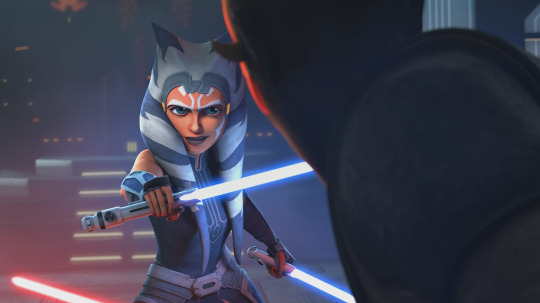
The Clone Wars creates a horror movie of inescapable dread in the game changing, “The Phantom Apprentice”
(Review contains episode spoilers)
youtube
Maul and Ahsoka Tano are now face to face. As the battle for the future of Mandalore unfolds around them, it becomes clear that something much larger is at stake. The fate of the galaxy hangs in the balance and everything that is known will change. And our heroes and villains are powerless to stop it.
It’s been known for quite a while that the end of The Clone Wars would tie into the events of Revenge of the Sith. The show has been on a collision course with this darkest installment in the Star Wars saga ever since it premiered in 2008 and now the inevitable moment has arrived. Everything in the galaxy is about to upend itself and the feeling of dread and tragedy hangs over everything. While The Clone Wars has dipped its feet into the horror genre before, director Nathaniel Villanueva and writer Dave Filoni have created a half hour experience of impending dread and terror.
The Clone Wars was always going to end in heartbreak. Revenge of the Sith was the inescapable end point for this series, but the unspoken cruelty of this series is in the unaware insignificance of its own cast. Ahsoka Tano, Rex, Maul, the Mandalorians are doomed to be side notes in the galaxy altering Skywalker Saga. Their narratives are twisting, emotional, and undeniably engaging but they will never escape living in the margins of the adventures of the mythic figures they count as their friends, allies, and enemies. There is a knowing futility to Filoni’s script for “The Phantom Apprentice” that pervades everything. We can be watching titanic battles unfold on the streets of Sundari and daring lightsaber duels, but it’s all for nothing. Composer Kevin Kiner, still the only musical talent that has come close to mirroring and expanding off the legendary work of John Williams, turns the aural landscape of this conflict into a sound that can only be described as Star Wars meets Hereditary. We are never once made to feel comfortable. There are no hints that this will work out. It won’t.
Like the standout season finale to Star Wars Rebels’ second season, the title of “The Phantom Apprentice” is deceptively nuanced. It’s actually in conversation with three different characters, one of whom never actually appears on screen.
The most obvious of the three is of course Maul, the original apprentice to The Phantom Menace. I’ve never hidden my adoration for the long, strange character arc that Lucasfilm Animation has taken this formerly one note villain on. Sam Witwer, Dave Filoni, and the rest of the creative team have transformed this former Sith assassin into a perpetually broken and emotional frail man that is never more than a few steps away from collapse. First hinted at in one of his first appearances on this series, Maul was always aware to some degree of The Clone Wars and the larger machinations of his master. The pieces were always in place and now Maul is slowly realizing that the end goal of his master’s decades long plan is finally upon them. And it terrifies him. Long gone is the confident Maul who thought he could carve out an Empire for himself in the shadows of the galactic underworld. After Darth Sidious’s humiliating beatdown of him in “The Lawless” and the murder of his mother in the Son of Dathomir comic series, it’s now clear to this lost Zabrak that his master is the most powerful being in the galaxy and something to be feared above all else. Witwer plays Maul’s former anger and jealousy at having his dreams of grandeur robbed of him as a transformation into existential collapse. He realizes that he really is nothing more than a cast aside bit player in the revolution that is about to come and he is determined to stop it from happening. Not out of any kind of good will or redemption, but out of his own desperation for survival and relevance.
I’ve always been a tad skeptical of one of the final confrontations of the series being a duel between Asoka Tano and Maul. Not at all because Ahsoka isn’t capable of taking on a character like this wayward former Sith. She’s more than proven herself able and “The Phantom Apprentice” more than sells that Maul is definitely not acting at full capacity. (We’ll talk more about that fantastic confrontation later along with the rest of the stellar action here.) Instead, I was concerned that this clash would feel hollow. Ahsoka and Maul do not have an existing relationship prior to “The Phantom Apprentice.” Their big climactic meeting of sabers could have been nothing more than a set piece that was created only because they were the only characters free during the Revenge of the Sith era to have one. That is very thankfully not the case.
Filoni smartly positions Maul and Ahsoka as two sides of the same coin. As Maul was eventually cast out and discarded as useless by Darth Sidious, Ahsoka was also tossed away by the Jedi order by their own dedication to doctrine and lack of trust. Both are victims of their respective order’s worst qualities and exist as relative outcasts. However, the true dramatic irony of it all is that by doing so, both Ahsoka and Maul are arguably in better positions to survive the coming slaughter and possibly put an end to it. Sure, Maul’s argument for their teaming up to stop Sidious is mostly self-serving (even if I suspect that it does have some root in the sad sack of a Sith’s perpetual need for companionship and belonging), but Ahsoka considers it for a moment because she can see the truth in it all. It’s a fascinating moment and the fact that it feels emotionally genuine is a true feat of Ahsley Eckstein, Witwer, and the entire creative team. We can’t not acknowledge that incredible shot of the shattered glass and embers blowing through the wind as Maul’s fateful offer is made.
The final apprentice is of course Anakin Skywalker. Perhaps the most startling development of “The Phantom Apprentice” is Maul’s revelation that he is more than aware of Anakin’s eventual slip to the Dark Side and it was probably in the cards for quite some time. (His moment of post-mortem pity for Dooku is a fun wink to how doomed all of Sidious’s apprentices were on their eventual march toward Anakin’s ascension.) It recontexualizes so much of the final days of The Clone Wars and of Sidious’s plan itself. Of course as Anakin’s fateful seduction to the Dark Side is occurring parallel to the events of the Siege of Mandalore it is more than fitting that Maul is not the only one with Anakin on his mind. The brief call between Obi-Wan and Ahsoka comes from a place of compassion, but it ultimately serves as further example of Ahsoka’s suspicion of the Jedi. She sees a kindred spirit in Anakin at the moment that the Council betrays his trust and how could she not. The fact that Ahsoka and Maul’s duel happens mostly as a retaliation to the assertion that Anakin will fall speaks to her unbreakable trust in her surrogate older brother. It ends up playing as a bit of a fight for Anakin’s soul. Hope versus despair and denial versus inevitability.
And what a battle it is. Dave Filoni mentioned at Star Wars Celebration last year that they brought in original Darth Maul stunt actor Ray Park to assist with the animation for this fight and it certainly shows. While it may not be the most sprawling duel ever or as brutal as Pre Vizsla and Maul’s duel to the death, The Clone Wars has never featured a confrontation as fluid and dynamic as this one. The constant back and forth of the upper hand and the emotional instability of both fighters gives this encounter a strange edge that ratchets up the tension even if we know both combatants are destined to make it out of this alive. The final stage in the scaffolding that holds up the city of Sundari is a standout and brings to mind a similarly stellar set piece from Mission Impossible: Rogue Nation.
It’s not just our phantom apprentices that get in on the action this week. A claustrophobic showdown between Bo-Katan and Gar Saxon in an elevator shaft is one of the most inventive set pieces that the series has produced and Villanueva sells it with a cluttered intensity that never loses clarity. A prolonged battle between the liberating forces and Maul’s loyalists is similarly brutal and striking with sweeping tracking shots of the action that smartly know when to cut into the carnage and when to transfer back to other scenes. It brings to mind some of the great multi-tiered battles in Star Wars history and it once again gives big screen live action installments of the franchise a serious run for their money.
A few random final thoughts!
It seems only fitting that Almec would be gunned down by one of his own allies. Gar Saxon is poised to take over Almec’s position as the self-serving Mandalorian leader in the era of the Empire and there’s certainly some poetry in this sort of cyclical killing. Poor Mandalore. Planet’s not going to sort itself out anytime soon.
Jesse lived! I’m sure every one of us clone junkies were prepared for one of our last surviving 501st boys to fall to Maul this week, but through some small glimmer of positivity the newly minted ARC Trooper survived. I’m not sure we can be as hopeful in coming episodes, but I’ll take the positivity where I can find it.
I actually really loved Maul’s cameo in Solo: A Star Wars Story and it’s nice to see “The Phantom Apprentice” tee that up with the blink and you’ll miss appearance by Dryden Vos. Was really hoping for a tiny line of dialogue from Paul Bettany, but I guess that’s as good as we’ll get for right now.
Sam Witwer remarked several months ago that the scripts for the final arc of The Clone Wars were the best the series ever produced and it’s hard to argue with that. Never before has this saga had more on its mind or felt as emotional or consequential. It’s a nail biting stunner of a chapter and I’m genuinely in awe that we are only half way done. Buckle in folks. This is when the pain really begins.
Score: A+
#Star Wars#The Clone Wars#Clone Wars#Star Wars: The Clone Wars#review#reviews#The Siege of Mandalore#Ahsoka Tano#Maul#Dave Filoni
54 notes
·
View notes
Note
Now that She Ra is over, what are your thoughts on it? What about that Catradora kiss?
Hi Anon! Thank you for the Ask!
ヽ(*⌒∇⌒*)ノ Where to start?
I have so many thoughts on the show, and I’ve had so many thoughts since season 1. I’ve not written much of anything about She-Ra because I keep coming back to this problem of ‘where to start,’ or how to structure my thoughts beyond a +1000 item list. I can’t even pick one or two thoughts to dive into, because they all end up connecting to everything else —> honestly, that’s the mark of a tight narrative, even the big pieces that can fully stand on their own are still leading through to another piece. I fail at every attempt to write something brief.
Section I: Short answer first.
I have a very short and subjective list of media where I not only love (for different reasons) nearly every character (main, secondary, background), but where I also feel that their individual places or moments or arcs concluded in a way that felt right from start to finish. It’s a short list of media where connections and conflict between characters never felt forced, out-of-place, out-of-context, or done for shock value. She-Ra and the Princesses of Power makes that very short and subjective list.
It’s not often that a story hits all the right notes with me, and it’s much more often that a story starts off strong like that, and then turns me off ½-⅔ of the way through. I’ve quit video games during the final boss fight because the story lost me in the lead-up and I wasn’t going to waste 10-20 minutes of my time for something that turned out to be ‘meh’. It ain’t got to be deep, or anything either.
I really loved the voice acting. Everyone is great. A post for another time.
I love the aesthetics, which I wasn’t sure of at first teasers, but won me over in less than 3 minutes of the first episode (season 1) because I love bright pastels, the character designs are fun (can I still gush over variety of body types? YES), so many opportunities to explore stylish takes on the characters, and those Moebius-inspired scenery/background designs are a special interest delight. Season 5 delivered a visual ‘end game’ for the aesthetics in many ways, Section III further down will get into that a bit.
Section II: “What about that Catradora kiss?”
I gotta preface this with, shipping is not my go-to for how I enjoy creative works. It’s not a hobby for me. Sure there’s a few I dig more than others, but I’m otherwise agnostic about ships, unless there is a really bad story-fit (and that’s usually a subjective thing), or involves tropes that are a deal-breaker for me (and those typically relate a lot to the story fit).
With that said, I’m really happy to see Catradora be pulled off so brilliantly, and I think the kiss is a bold and beautiful big deal in a way that might not be obvious when considered in a vacuum. I see it as passionate and heart-felt, but also, it’s achieving(?) a relatable outcome (for me at least) that’s hard to describe. It’s an outcome yielded by a story in which two women—a hero and a villain—are divided and fight bitterly and then reconcile through love, while fighting a purity cult whose founder-prophet-god-king forces subservience through a conversion designed to strip someone of their identity (e.g. names they’ve chosen for themselves), memories-and-motivations, and love for others.
Despite these conversions, love still remains, it can’t just be baptized or therapy-ed away. Controlling puritans and authoritarians wielding religion or peace-panaceas as a weapon have been the villains in the lives of countless women and LGBTQIA people for a very long time. So yeah, I’ve got some feels about that. The last time I felt anything similarly relatable, or as strongly, was the Utena and Anthy relationship in Revolutionary Girl Utena (and really, their kiss during the surreal sequence at the end of the film adaptation).
Section III: Thoughts on Cult Aesthetics and Clones (the rough cut)
(1) In the future scenes at the end, Adora’s white dress with gold tiara and accents have this kind of goddess-like or Pallas Athena feel to it, which is a great mirror of the design choices for the god-like Horde Prime, his Purity Space Cult, mechanics/ship, and flagship interior scenery. Not saying that was the intention, but that’s how it came across to me.
Of course, those colors would be used because She-Ra already wears white and gold with a bit of red accent, which complement how the princesses are bright and colorful (pastels and jewel tones). The bold and bright colors helps signify that Etheria is full of life. Etheria is verdant and magical, and that sets up a contrast to the Fright Zone and the darker colors found in Horde characters (Hordak, Shadow Weaver, Scorpia, Catra, Entrapta, etc).
So the first kind of contrast was with the Fright Zone standing out as a poisoned/toxic against the bright, lively colors of Etheria and the princesses. Season 5 introduces another take on that contrast as Horde Prime is the opposite, or antithesis of Etheria’s colorful life. He’s like anti-life with his shades of light-and-dark grays on white, and only glow-green as an accent. In some cultures and religious traditions, white is associated with purity, and in others it is associated with death.
When Horde Prime ‘purifies’ Hordak for the sins of individuality and emotion (emotion for others, for his own sake), Hordak is drained of the colors he chose for himself during exile. In addition to being a contrast to Horde Prime (and informed by the 80s cartoon design), Hordak’s dark blue (or blue-black) and red color palette reflects the traditional use of red as a color for evil (especially vampirism) from back when diabolism was a stand-in for ‘the Devil’ in many forms of visual media (comics, live-action, animation, etc). In place of diabolic red, Horde Prime has toxic glow-green.
I absolutely love the use of the glow-green accents. Color trends for villains and significations of evil come and go, and I’m glad to see the color green be used again, and used so well. The last time I saw that shade of glow-green used so well was in Sleeping Beauty (re: Maleficent’s magic and the orb on her staff) and as the Loc-Nar in Heavy Metal. In both films, there are connotations of evil as a poisonous and corrupting influence. Green, in the context of evil, almost always signifies poison (and sometimes envy). I also like that the glow-green color is used in ways that aren’t immediately saying ‘this is evil’, such as the green baptismal waters and flames from the purification scene, or the green amniotic protein fluid. The language of piety and trappings of the sacred can cloak a sinister purpose.
I don’t know if any of that was intentional, but Horde Prime feels like the perfect synergy of purity and death (which has additional connotations, but that’s a very personal interpretation).
(2) Horde Prime immediately gave me subtle cult vibes in his first cameo (Season 3), and the follow-through on that was perfect and exactly what I was hoping to see. The background music throughout the scenes aboard the flagship fits well (love the soundtrack), and has the quality of Ecstatic Experience without pulling directly from any specific religion. Horde Prime’s dialogue is a delightful bit of narcissism veiled with the language of piety.
A purity cult comprised of clone-brother-worshippers of the cult’s founder-prophet-god-king reinforces that narcissism and has all the fun-dark feels of shiny-techno-future-dystopias. It is also an interesting use of clones, especially in a story format that usually never has the time to really dive into the complexities of cloning. This is the sort of thing that you’d be more likely to see in a one-off episode of Star Trek: The Next Generation, rather than the basis for a greater scope villain, or multi-season nemesis. (and yes, Star Trek: TNG had an interesting clone episode)
Clones in science-fiction tend to fall into just a few tropes, and I generally dislike seeing clones show up in a story because the execution nearly always feels sloppy (in small ways or big ways). I did not get that feeling from She-Ra, where, the clones occupy the “cog in the machine” trope, but it is not their existence as clones that make them that way, it is the Will of Horde Prime that does. They are simultaneously expendable and sacred in their unity. It’s a nice flip on “stronger by working together” that Adora and the others have to learn (and struggle) to do.
It seems like, despite their religious programming, the clones have a little bit of their own personalities until Horde Prime ‘inhabits’ them to exert his Will. I’m trying not to read too much into it, b/c what comes across as ‘inhabits’ to me (especially with the religious/cult context), was probably meant more literal like described in the dialogue as a hive-mind control kind of thing. The first time it happens—to post-wipe/death Hordak—felt to me like a possession scene from The Exorcist, but without the kind of horror visuals that would scare both adults and children. The quick-and-subtle amount of body contortion and sound is still gross and creepy (because it should be), but it also reminds me of Ecstatic Experience in the form of speaking in tongues, or snake handling, or being a medium for a spirit. Again, I’m not saying any of that is intentional, but that’s how I see it.
(3) Finally, there is Entrapta, Hordak, and Wrong Hordak. Clones rarely get to be ‘humanized’ through friendship or romance arcs. I can think of a dozen or more robots that get to be humanized in that way, but can’t recall any clones that have (excluding doomed clones whose friendship/romance only existed for the sake of selling the tragedy of their death). Hordak gets death, renewal, and romance in a way that worked really well, and the totality of it is unique. I was a bit surprised that they could work in another clone—and I love Wrong Hordak—who pulls triple-duty as (1) comedy; (2) relevant to moving various pieces of the story along; and (3) more humanizing of the clones, which, again rarely happens as most stories take the easy low road when it comes to clones.
For Entrapta’s part, she’s never put in the position of giving up who she is (‘weird’ by many standards) for a romance. Her passion for technology is both an amusing double entendre at times, and integral to who she is. A romance for Entrapta does not replace her passion for technology, she can have both. Dating myself but, I came up in a time where most media (for children or adults) would rob a woman of her agency or passions during the resolution of a romance arc. Maybe times have changed, but it’s still nice to see none of that nonsense happening here.
31 notes
·
View notes
Text
Uncharted 4: An Era’s End
It’s recently come to light that game developer Naughty Dog has been subjecting its employees to crunch; the practice of overworking and underpaying staff in order to meet deadlines. This is not unique to Naughty Dog, nor to their current project pending release later this year, The Last Of US 2. Reports suggest that crunch has been endemic in the working culture of Naughty Dog for some time and this is now no surprise to us as such reports continue to surface about studio after studio, most in the corporately structured, premium funded and managed space we call “triple A” or AAA, but many smaller studios and independent spaces also. Several senior and long-tenured creatives have left Naughty Dog quite recently, and some may have been leaving earlier than those that have been reported during what’s turning out to be a turbulent development cycle for The Last Of Us 2.
Each month, as part of the paid subscription to the Playstation Plus online service, Sony offers a small selection of games. For April, one of them was Naughty Dog’s Uncharted 4: A Thief’s End, from which I derived my title. Not only am I here to suggest the studio’s troubles may have begun during the development of this game, first released back in 2016, but the title may have been one of the first significant indications that the book was closing on AAA development as we know it. I appreciate there have been many good voices shouting from the rooftops about the how unsustainable it’s been from before then, but the Naughty Dog for a long time seemed like a light in the dark, signalling that a big studio could still produce good product under strong leadership.
I feel that Uncharted 4 rather than The Last Of Us 2 is the real light, and instead of a light-house, it turned out to be a signal-fire warning that even then the composure of Naughty Dog was an illusion.
This piece is going to contain significant spoilers for Uncharted 4. It’s also not investigative - I just played it for the first time, completed it and I have some thoughts about it; these are my thoughts.
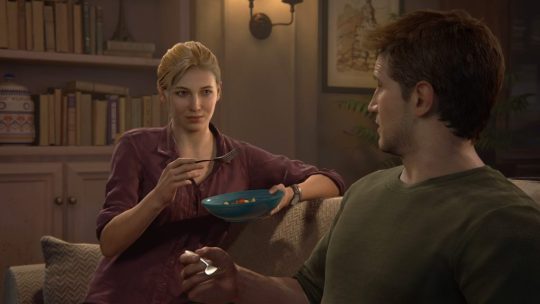
I didn’t like the third game at all. I took nothing away from it. I’ll never play it again as there’s nothing I want to relive from it, so I’d better look up the wiki on what happened in it... well that didn’t help at all as I don’t remember playing any of that, it was so unmemorable. I remember the wandering around in the desert bit and then some shooting in the desert which was all pointless. There were also some puzzles with shadow puppets that were almost good but so short and pointless, those two things sum up my feelings about the third game entirely.
What a way to start.
I’ve replayed the first and second games once each, so I’ve played those each twice thru and have decided that the first game is overlong and poorly paced, and the second game is the best and probably two-thirds good. Honestly, Elena should drop the Drakes in the ocean, run-off with Chloe and keep in touch with Sully because those are the only three characters with any depth and meaning. Let’s roll-back a bit.
I get that Nathan’s supposed to be a charming, happy-go-lucky character and for the most part, it works. Maybe I’m just getting too old for it or it’s wearing too thin. I really think the third game was completely unnecessary. When I review my notes on the fourth game, I think about the emotional quandary it attempts to set up i.e., ultimately that Nathan should be more honest with Elena - spoiler; he isn’t, but don’t worry it all works out *SPIT* - this was already a problem I was ready to face at the end of the second game. Given my feelings on the third game, I’d have much preferred a simple trilogy and conclusion that faced that emotional brunt to wrap things up. Naturally of-course, that’s not how money-spinners work.
If Uncharted 4 doesn’t spend time on Elena, who does it spend time on? Nathan has a brother! To be fair, I love Troy Baker as a voice actor and if there’s one thing that is consistent in Naughty Dog games, it’s excellent voice acting. I don’t know if I’m now biased after seeing so much of Nolan North and Troy Baker on YouTube outside of their VO talent work, but they’re wonderful people and their professional work is always great. The supporting cast is always great, too - so too the villains even if the narrative arcs are always completely absurd. I know these are always a bit of a lark, you can’t take them too seriously so I can’t hold Uncharted up to Kentucky Route Zero (got my mention in) and shake them comparatively, that’s not fair. It’s OK to have an excuse for a romp even if it does wear on a bit over time.
The problems I have with Uncharted 4 specifically are things like the level and environmental design. I’ve never gotten lost in this franchise up until now when it happened in almost every level... several times. I simply didn’t know where to go. There would be absolutely no clear indication of where to go and no assists, no subtle environmental guide and no camera nudges to help. There is a timer that eventually tells the player where to go and at times, this is tied to deaths so at one point I just threw Nathan off cliffs repeatedly to respawn until the hint appeared. This is unquestionably stupid design. I began to wonder if this was due to criticism that previous games had too much hand-holding, but when the UI assist was finally given and I made my way to the next check-point, I would *never* have found it under normal exploratory gameplay.
This remained true during several moments of scripted action sequences, some including during combat which brings up something else I now remember about the third game. I still couldn’t tell you when it was other than I didn’t know where to go and it was stupid, so there you have it. Maybe the third game was the real signal fire in my metaphor, who knows. In any case, constantly reverting to check-points and having to repeat, not understanding why you’re failing when the game isn’t telegraphing what you need for a success state in a scripted sequence is an exercise in frustration I’m not willing to ever repeat. While I’m not a souls-like player, I completely appreciate the admiration and respect for those games because they have rules that are clear to parse. Video games are *all about* providing feedback to the player. I’m not saying it’s easy, it is an incredibly difficult thing to achieve but it is literally the job you set out to do, it is the only vehicle you have to convey the lofty emotions you want to communicate to your audience.
And then there’s the driving. Naughty Dog. Do not put driving in your games. This is something you’re not able to do.
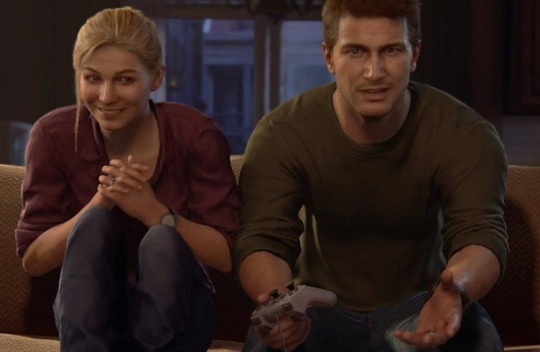
I don’t want to bash the driving so hard because at this point I feel like it may have been bolted on without time to make it stick correctly. This is the first game in the title where the hot-zones for interactions weren’t quite right. Where I bugged out of animations and had check-points or re-spawns instanced or loaded. Where I glitched out and fell off things, where I had to walk back and forth in-front of things to make buttons appear. The edges of that Naughty Dog polish were fraying. I’d attempt to do a thing and it just wouldn’t work, I’d fall to my death. I’d attempt to do the same thing the same way and it would work. Again this is dredging up more nondescript memories of the third game so I’m beginning to have my suspicions about the working environment there and when in the timeline things started getting bad - but cameras and jumping distances got really difficult to judge. One gap at one time would be fine to jump, then another would have you plunge to your death, and they’d be inconsistent to read or judge. These were not frequent, as with the third game, almost as if the artists and level designers were given time to adjust lighting and camera geometry tracking and control mapping as much as possible but just couldn’t get to them all. But throughout the games, it creeps in more and more.
I’d talk about combat - it’s functional, but it’s not interesting. These games don’t add anything interesting to the genre or video games in general. I play the games on easy because I don’t need to prolong the experience, I don’t actually have the physical time - if I could play the games without combat, I would. There are other games to play if I want dexterity challenges which I do engage in, Uncharted isn’t one of them. Even in 2016 I’m not entirely sure this would have turned heads. I realise I’m playing this a full four years later, but it’s hard to think of the sum-total of this game’s parts and see it as relevant...
But you know what? Uncharted 4 visually looks immaculate. Outside of the voice-acting and sound design, without question, the highest priority has been given to the visual fidelity of this game inclusive of the animations. So much has been invested in how the tech works, to the abandonment of everything else, I’d say the for example, the driving suffered the most, level design next, then interaction scripting. The attention to detail in the environments is stupendous...
...yet it’s all hollow. You know what? I don’t care about pirates and adventures anymore. Whatever. By the fourth game, I don’t care. I totally get that the game’s not for me but I played it and I’m writing how I feel about it. You’re telling me a story about a guy who met the person of his dreams and marries, then his brother turns up and he can’t be honest to his wife? Meow meow meow it’s all for the sake of drama so we skip over all the details but the contrivance is too much. You want me to accept these things on face value, then on face value, I say Nathan and his brother can go get fucked.
I took particular issue with the comically brief relationship discussion Elena and Nathan have after she saves him and they set off together in which she concludes she’s with him “for better or for worse”, which from memory the game chapter is titled after. Now either the character genuinely believes she owes him under the sanctity of nuptial obligation or she’s using it as a justification of such. This is a wholly unsatisfying discussion for me was when I finally checked out of this game - sure I should have done so hours before but this was the last straw and the indication that I am definitely too old for this shit - but this is a horrifying and stupid message to be spouting. Elena don’t owe anyone shit. Married or not, she’s free to save Nathan if she wants to, for any reason, but she’s certainly not obliged to. I despise this massive chunk of traditionalist patriarchy smashed into her character and the narrative, even if it is “well it’s just about her character” yea great, so that just re-enforces her as a loyal dog-trophy for the main character in the on-going male power-fantasy shenanigans shit-train. Nathan’s behaviour isn’t exactly selfish but it’s certainly not adult or considerate. He behaves like a child not taking on an appropriate level of responsibility. Others around him, being Elena and Sully, continuously bail him out - literally saving his life while endangering their own, and he continues to behave like a manchild that neither acknowledges their physical and emotional labour nor does he grow and evolve as an individual. What a fucker. Does he ever sort his shit out, ask Elena what she wants to do for a career and support whatever the fuck she wants to do with her life? Of-course the fuck he doesn’t. Know why? Because he’s a literal man-baby. And his brother is too. But that’s OK cos he’s a fucken jock-hero and a funny guy so as long as we can all laugh about it and the narrative says-so and it all works out in the end and he gets the girl and she ends-up supporting his career anyway, it’s aaaaaaaaaaaaaaaall fine.
Nathan should have died and Elena shouldn’t have given a fuck.
I know I know, it’s not that serious. Look I’ve been thru some shit, alright? I can see it both ways. Sometimes you don’t think about stupid shit that deep and sometimes you do. Most of the time, I do, and most of the time, I take it to the nth degree, so yea, shit like that gets to me. I call it bad writing, so no, I don’t like the story. At all. Nathan’s supposed to be flawed but nothing ever costs him. When people make mistakes in life, those mistakes cost. The unfortunately thing is the cost is most often paid by the others around them, and sometimes they themselves never realise it. I don’t like stories where there’s a fuckhead at the centre but everyone still stays happy. Nathan seems to have been given a lesson, but I don’t think he earned it. This is why y’all watch Game of Thrones and are surprised when characters die because you keep consuming narratives with no stakes, and GoT is *still* only middling stuff.
Anyway.
How could Elena’s character have been given more attention? Uncharted 4 isn’t all bad. The most valuable thing Naughty Dog achieved was the recreation of real domestic spaces; the Drake households. Twice, we’re given time and space and encouraged to explore them without being funnelled by level design, events, NPC shepherding or audio cues. Rooms and the objects that fill them are meticulously and beautifully created, and they're given life and purpose in a way that has meaning far beyond all the pirate nonsense that while almost as equally beautiful, is completely vacuous.
Putting on Elena’s vinyl record as her daughter Cassie was the only time I enjoyed the music in the game, and it was a great call-back to Nathan having done the same thing in their house much earlier. Sure, there’s the Drake theme that repeats ad nauseam throughout the series but otherwise the soundtrack is bland and unremarkable adventuring fare. It contributes more to the feeling of this game being out of touch, contrasted to something like Control which certainly has a completely different setting, sure - but that’s part of it, so that affords the creative team room for more modular synths and drones and to have a distinct sound.

Walking thru those houses, first as Nathan but really as the player repositioning themselves from adventurer to ordinary life-living person in a domestic setting, and then as Cassie - daughter of these two amazing characters in an equalling urbane setting yet filled with wonderful objects, made up the most fascinating and enjoyable moments of the game for me. The mess of each room gave the houses the perfect lived-in feel to a degree that most other games struggle to achieve, probably due to how much effort it takes to get that much geometry mapped in - Giant Sparrow’s What Became of Edith Finch is probably one of the few games that has come close. The difference between the tropical islands, decaying pirate mansions and the domestic Drake residences is that the houses felt like everything in there felt like it meant something and was in there for a reason, like it had been part of something. I don’t mean that just for the objects that were intrinsically tied to implicit narrative beats like collectables or even items from countries where Uncharted 4 or prior games are set, but also things like towels, washing baskets, plates and dishes, books and picture frames, shampoo bottles, food - the detail in the fridges! That you can feed Cassie’s dog, Vicky is the most meaningful interaction of the game - by the way, the second most meaningful set of interactions is buying an apple in the market in Madagascar then playing with lemur and letting it take the apple.
Back to the houses, I’m disappointed we never got to walk through one of them as Elena. Now that the core of the franchise is wrapped, I’m left with the impression that she’s the most important character in the series and she’s left woefully under-served. This is a very me thing, and unsurprising. I doubt anyone else cares enough about writing and character to have thoughts like this. They’re into Uncharted for the adventuring and the shooting, but as soon as you present me the opportunity for character drama and you want to have a red-hot go at it, I’m here to set aside the rest of that guff and go for it. The running and jumping and shooting never changes, and I’m here to say that the puzzling could have stepped up orders of magnitude that Naughty Dog never committed to - Crystal Dynamics did far better with Rise Of The Romb Raider, and while the puzzling was never really difficult, the way I described it to a friend was to liken the puzzles to desk toys; not intended to be too challenging, but more satisfying in their tactile nature. I feel Fireproof’s The Room series for iOS and Android are great examples of providing similar sensations.
I don’t mind a game mostly about shenanigans, I just don’t want it centred around a character that won’t learn, or who gets off cheaply. Elena is infinitely more interesting to me - her concerns, her desires - Chloe too, for that matter, and I absolutely am not above making the joke about shipping them as I’m sure thousands have before me (no I won’t write a fanfic about them, I’m sure there are plenty around).
I didn’t play the first The Last of Us. There was a horrifically jarring moment when the game felt it was over-playing its sense of cinema to me, then had a sudden camera zoom transition onto I think the first combat gameplay and I checked out. The tone of that game is trying to telegraph TAKE ME SERIOUSLY and I feel all I’m going to do is read tonally similar things to what I have here but far worse. Also post-apocalypse is easy pickings for bad writing, especially by video games narrative writers, I just don’t have the patience. I’m pleased that there’s lesbian representation in the second game but I’m not sure it’ll be handled with sensitivity. While I’m in no way invested in the game as a product, I continue to be concerned for the welfare of the employees at Naughty Dog, and all game developers everywhere, as always. It is a hugely unregulated industry that is in the process of slow collapse, and now more than ever do we need reform and cultural change.
And in the midst of that, one day we’ll get a decent game that’s about domestic partnerships and wonderful emotional relationships with stunning visual fidelity; maybe it’ll have running and jumping and shooting and maybe it won’t. Maybe it’ll end sadly and maybe it’ll end happily but hopefully it’ll be well-written.
Here’s to Elena.
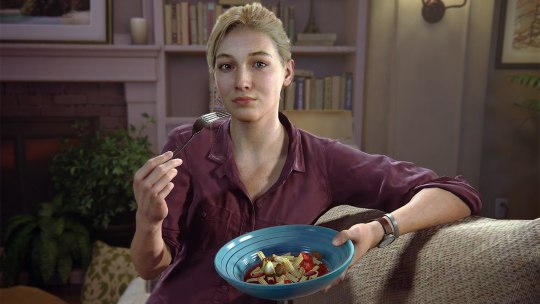
#Video Games#Crunch#Work Practices#Employment Ethics#Work Ethics#Naughty Dog#The Last Of Us#The Last Of Us 2#Uncharted#Uncharted 4#chrono#2020#rant#games writing#writing about games#video games narrative
12 notes
·
View notes
Text
203. Sonic the Hedgehog #135
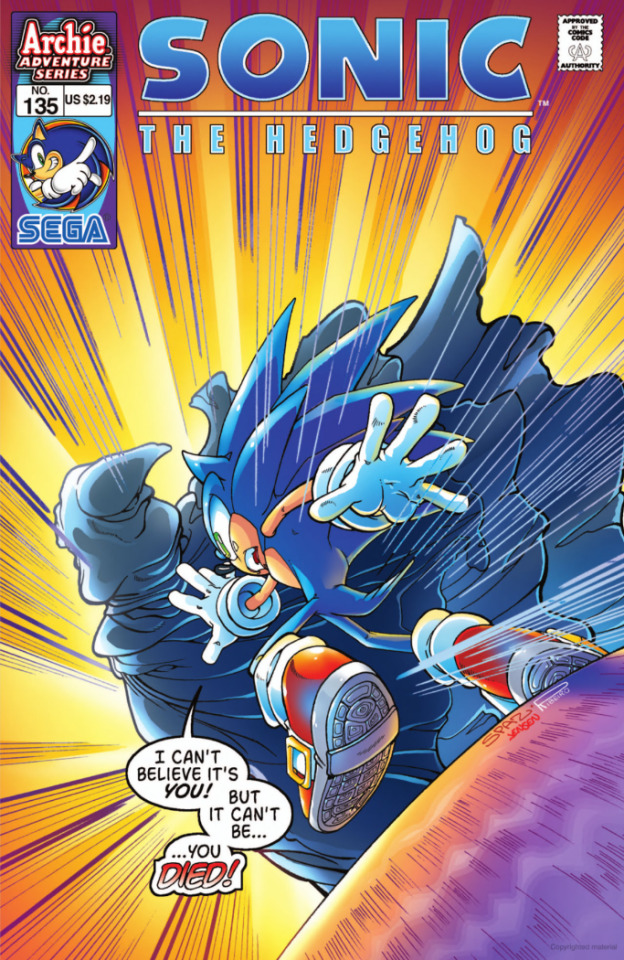
The Tommy Trilogy (Part One): Agents of K.N.O.T.H.O.L.E.
Writer: Romy Chacon Pencils: Ron Lim Colors: Jason Jensen
Well, the title of this story kind of gives away the mystery of the cover image, huh? Sonic finds himself once again traveling to the Forbidden Zone in search of a undercover contact who just so happens to be a turtle. Interestingly, his narration as he makes his way into the bar that they're supposed to meet in notes that though the Forbidden Zone is apparently under Eggman's control, the Mobians that live there have refused to defect to the side of Knothole, instead keeping their heads down and hoping to not get involved. This is the first inkling we've ever gotten of a population besides Angel Island trying to stay neutral in the war, and since Eggman has more important things to focus on than the residents of a small out of the way town in the middle of nowhere they've been largely successful so far.
As this is going on, in some undisclosed location, Eggman and Snively talk about a mysterious project of theirs. Whatever they're creating, apparently the first hundred models of it failed, but their hundred-and-first is operational. Sounds suspicious… Back in the bar, Sonic slides into a booth across from a similarly hooded figure, reciting some code words, and who pops out of his cloak but Tommy Turtle! Yeah, turns out he survived the explosion at the factory a year ago, and only recently managed to message Sally and Sonic about his continued existence.
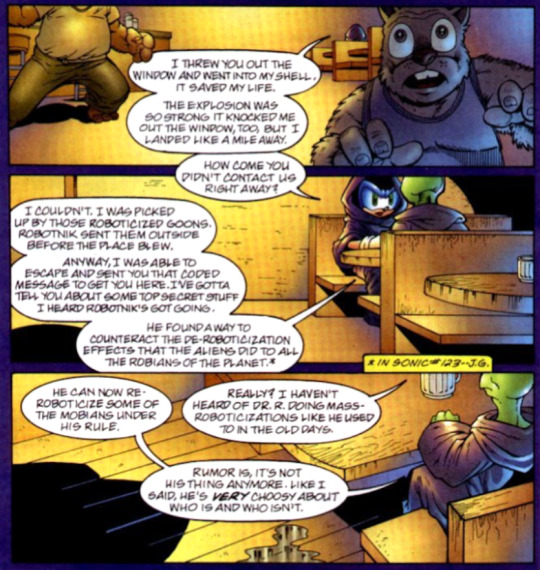
Now that's interesting. It seems Ceneca-9009 thought of everything, and tried to make sure that a Mobian once deroboticized can't be reroboticized, but somehow Eggman has found a way around that. Sonic and Tommy's conversation is then interrupted by none other than the same "friends" Tommy was hanging around last time we saw him - Sleuth Dawg, Drago, and the Fearsome Foursome, all roboticized once more! What a conveniently relevant conversation there, guys! The roboticized goons try to place the two friends under arrest, but Sonic easily dodges their attacks and begins kicking their metal butts with ease. He even gets his chance to throw in some sass here and there - but Tommy isn't doing as well as he is, being a noncombatant.
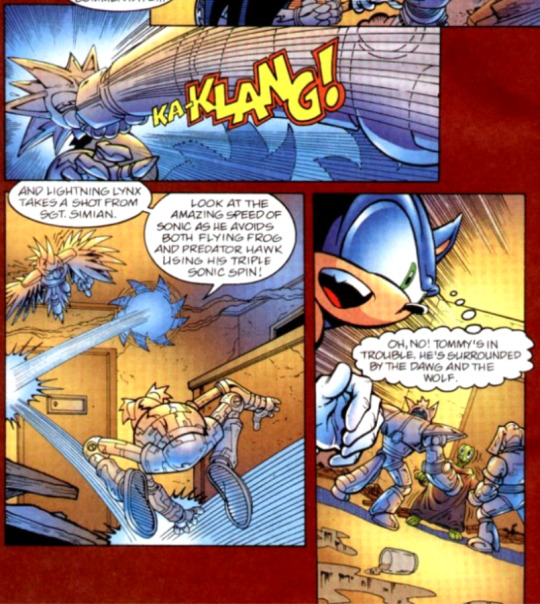
Sonic decides to hurry things along, finishing off his own opponents and rushing to Tommy's aid. However, he's startled to find that somehow, Drago and Sleuth have both disappeared from the scene, with Tommy looking perfectly unharmed. Tommy explains that he was able to hotwire the two of them and reprogram them to go throw themselves into the nearest lake, and that's good enough for Sonic. Together, the two leave the messed-up bar behind, with Sonic glad to have Tommy back and alive once more…
Anonymous
Writer: Romy Chacon Pencils: Art Mawhinney Colors: Jason Jensen
So what exactly is the deal with the roboticization thing, anyway? Time to find out in a story that clearly takes place before the previous one. A.D.A.M. gets Eggman's attention in his base and directs him into a room where stand the six villains of the story prior, all roboticized and awaiting commands. The twist? Eggman didn't do it. He's just as surprised as we are to see them standing there roboticized once more. Eggman is of course eager to find out who has managed to reverse the anti-roboticization effects on them, and has A.D.A.M. run diagnostics on their memory banks to find any useful information.
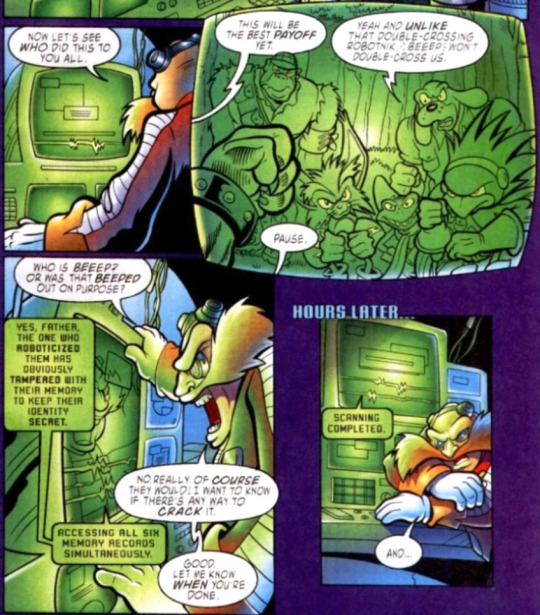
Several hours later, A.D.A.M. rouses Eggman from his nap only to give him the bad news - their memory banks are totally locked down from accessing information about who retransformed them. The only thing he was able to find was a brief image of their benefactor, which has been similarly censored out, leaving only the impression of someone Eggman-sized behind. The final piece of information A.D.A.M. is able to retrieve is that the person behind it has signed their work merely as "Anonymous," which only frustrates Eggman more, as he has no idea if this person is friend or foe. Hmm, so the famous hacker group is behind this, eh? Watch yourself then Eggman, they tend to not like fascists.
Mobius 25 Years Later: Dealing With the Devil
Writer: Ken Penders Pencils: Steven Butler Colors: Jason Jensen
It's time for another riveting piece of teen drama! Lien-Da, after dropping Salma off at home, is ready to interrogate Rutan about where he was last night. Rutan isn't looking forward to the repercussions of his actions, but is grateful when Dimitri steps in to give his two cents.
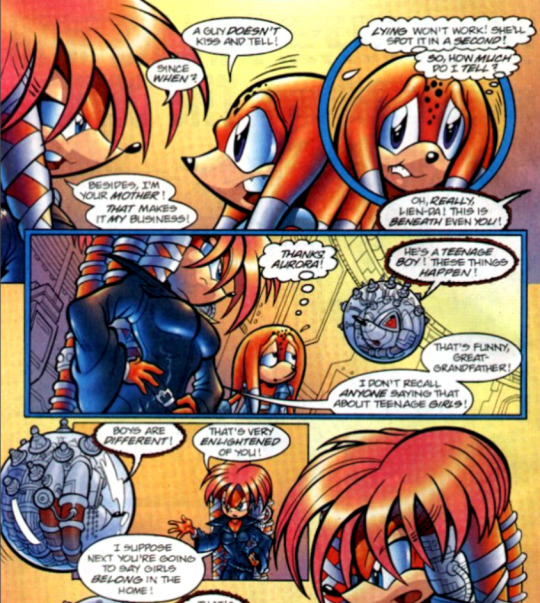
This sucks in so many ways. Like, how can you make me cringe so much from just a few lines of dialogue? Yes, teenagers often want to sneak off to make out with their crushes. Lien-Da should know this, especially as she appears to be a single mother with no father in sight, indicating Rutan is perhaps the result of a one night stand. But then Penders has to go and make it all weird and have Lien-Da get like, bizarrely feminist on Dimitri, and not the reasonable kind of "I just want equality" feminist, more the "rabid social justice warrior who takes offense at everything" kind of strawman feminist. When has any of this ever been established as part of Lien-Da's personality? Why did we need this weird "man, boys and girls are sooooo different" tangent? It's just… so weird and out of place.
For a moment, we actually take a turn into something mildly interesting - that is, the matter of how exactly Lien-Da and Dimitri got to be where they are today. Apparently, at some unspecified time in the past, when Eggman's empire was on the verge of crumbling, he captured Dimitri with the intention of using him to somehow fix everything. When Dimitri refused, Eggman took his revenge… somehow, which resulted in Dimitri becoming the disembodied head that he is today. Lien-Da thinks that he holds a grudge against her for not saving him from his fate, but he retorts that he's only angry because once he was incapacitated (and decapitated), she drove the Legion forward in her own self interest instead of following his vision… which we're not even sure what it was supposed to be in the first place. Again, all of this is extremely vague - seriously, this entire story arc seems to want to gloss over everything that could actually be interesting in favor of the awkward domestic dealings of heroes past their prime and their annoying, bratty offspring. Lien-Da cuts the budding argument off at this point to go right back to the clearly most pressing question of the evening - namely, what exactly Rutan was doing with his girlfriend last night.
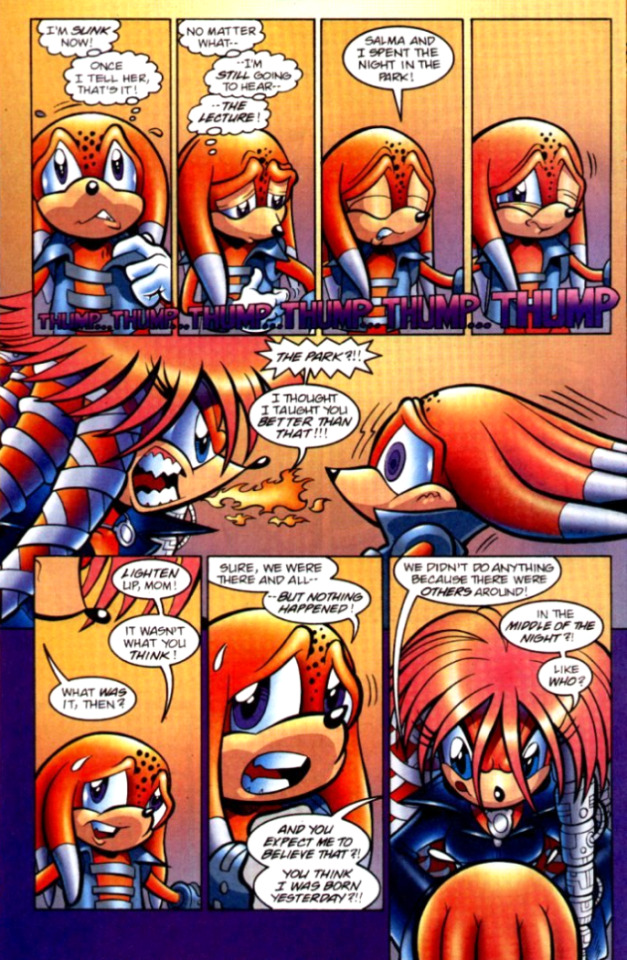
I love how this entire thing comes across as though Penders thinks he's danced around the issue of teenagers boning oh so carefully, when really it's done with all the finesse of a drunk baby deer trying to navigate its way through a room full of glass figurines. Like, who do you think you're fooling, dude? A five year old could read this and know you're talking about sex. Furthermore I'm trying to decide if the shocking part is that Rutan was trying to get it on with his girlfriend at all, or if his mother's life lesson was merely not to lose his virginity in a park specifically. Either way, he's able to deflect her anger by relating what he overheard of the conversation between Knuckles and Rotor, which granted, isn't much. However, it's enough to catch Lien-Da off guard, and after thinking for a moment, she suddenly gets unnervingly sweet, saying that she believes him and sending him off with a firm "just don't do it again" to his room. Rutan catches the chill from her sudden attitude shift and leaves gratefully, and when Dimitri tries to talk to her, she brushes him off, clearly calculating her next move. Next thing we know, Julie-Su, chopping vegetables for dinner, finds herself getting a video call from Lien-Da asking to talk…
Again, though, I just have to point out that nothing we're seeing makes any sense here. Everyone is so scared of Lien-Da finding out anything important, but if she's so dangerous, then why hasn't she been arrested and incarcerated for her former crimes yet? Either she's a dangerous terrorist who should pay for her transgressions against echidnakind, or she's a reformed and upstanding member of society. You can't have it both ways, guys! And now, with the new information gleaned from her son, she's all ready to scheme and plot her way to… what, exactly? The only thing she knows as of now is that Knuckles and a friend of his met in a park at night so that the latter could make a request of the former. How does she know it's anything important at all? Remember, Rutan didn't overhear anything about spacetime breaking down, so for all Lien-Da knows, Rotor just wanted to ask Knuckles if he could borrow his hairdryer. There's nothing here to even begin to be suspicious about! This entire arc is held together with duct tape and Penders' tears, and there's so many weird plot holes that rely on us essentially just taking Penders' word for it that this person is bad, and that person is totally in character, and this other person is at all interesting. And I hate to say it, but we haven't even seen the worst yet! We've yet to see King Sonic and Queen Sally enter the picture, and once they do things only get weirder…
#nala reads archie sonic preboot#archie sonic#archie sonic preboot#sonic the hedgehog#sth 135#writer: romy chacon#writer: ken penders#pencils: ron lim#pencils: art mawhinney#pencils: steven butler#colors: jason jensen
9 notes
·
View notes
Note
How would you relaunch Quasar
Okay, i’ll finally answer one of these ones.
I think Quasar is a character who doesn’t really need his own series.
But if he does I think there’s a few things that need to be taken into consideration.
Firstly, more than anyone else, we have Quasar and he is very much a character defined by one creator - Mark Gruenwald. To do a Quasar series and not in some way have it reverential to Gruenwald would be absolutely the wrong idea. There should always be at least some element of a love letter to Gruenwald in the book, be it continuity, his characters, running with his ideas or so on. It shouldn’t be weighed down with that stuff, that shouldn’t be it’s be all, but just the book should maintain elements people recognise as being in-line with Gruenwald. I think i’d want a Quasar series that i could see Mark Gruenwald picking up and being happy with - and that obviously doesn’t mean just copying him or rehashing - just something where he could go “it’s nice to see these creators appreciated my run so much and are continuing Wendell’s adventures”.
Secondly, this is all my ideas and yes i’d kinda love to write a Quasar book (or rather co-write/co-plot one with someone talented)… but a lot of the points i think should be applied to a Quasar book in general.
The start off with, I think Quasar needs to be re-introduced… we’ve already got him de-powered and stuff… i’d be slightly tempted to do an upbeat take on Dark Knight Returns (Quantum Knight Returns?) but that seems like it will have been done, not quite work or just be uninspired. The first issue is probably the hardest, because it’d have to get Quasar back as Quasar but in a manner that can grab new readers and tell a story. I think maybe something with the Quantum Bands being at Project PEGASUS and Wendell being the only one who can use them or a bad guy stealing them and Quasar taking them back before they burn themselves out. But both these seem too reminscent of past stories. I don’t want to just have Epoch show up and say “be Quasar again” coz that is lazy
But once we get passed that, I do think there is a very good unique model for a Quasar series. Quasar was a book always concerned with continuity or using continuity to tell new stories. Gruenwald’s series obviously dipped into this with stuff like the Ultimate Nullifier, the M-Bodies or just resolving loose ends like the Questprobe series or Iron Man’s Secret War armor. In my mind, a Quasar book could be the book that tells the story or stories about the MU. Think “Untold Tales of the Marvel Universe” meets … well, Quasar. It can be a bit like a illustrated Handbook but with a relevant narrative and stories spining out of it. For example, Quasar can learn about how the Celestials came to be or how the Uranians depicted in Quasar #2 and Untold Tales of the Marvel Unvierse work in conjunction with the Uranians depicts in Agents of Atlas or even resolve old loose ends from other books. Quasar is the perfect P.O.V. character for these sorts of things as he has a personality that would process these things the same way the reader would. It of course though is a Quasar series and these sort of continuity porn stories are small ideas or themes that could give the series a more unique approach - one of exploration and slightly different Cosmic adventure. There’s still plenty of other things a Quasar series needs…
There’d be much of the same sort of expected stuff - Quasar going into Space, Quasar fighting one of his rogues gallery, Quasar having down-time moments with his supporting cast, Quasar getting involved in crossover events, huge sprawling arcs and sub-plots, some stand-alone issues.
Plenty of stuff to focus on in Quasar.
For example; baddies.
I’ve got a “rule” that i think is better than anyone gives it credit. I think any property that doesn’t have 12 unique villains will eventually fail as a book. The idea is that they have 12 villains who are unique to them (or would/could be considered “a Quasar villain” above “a Fantastic Four villain”) so that feasibly there is straight off the bat at least a year’s worth of stories to tell. I don’t mean that it should just be a cycle of those 12, ever, but that if - say - the book ran into trouble, there’s at least a year’s worth of potential safe stories to fall back on.
Quasar is rare in that, I do think he easily has 12 unique villains. I was gonna name them all but it became long. Suffice to say, Maelstrom, Ereshkigal, Deathurge, Quagmire, Presence, Marvel Boy/Crusader/Blue Marvel/Thelius, Soul-Eater, Chief Examiner and Overmind are the “big ones”. There is honestly loads more and I think Quasar, combined with the above purvey of incorporating continuity, has potential for a really robust list of cool underrated Cosmic villains and obscure villains who can be redefined.
I think there’d be no contest to the decision to go with Maelstrom as the arch-enemy (with Oblivion as the obvious big big bad). Though i think Ereshkigal and Presence are both worthy arch-enemies if Maelstrom was unfortunately unavailable (though if I wasn’t allowed Maelstrom, I’d begin doubting whether or not a Quasar book would be as open to me as it should be - if you’re told you can’t use the book’s obvious arch-nemesis, what chance do you have of ever getting to do something with, say, The Stranger?).
Supporting cast is a lot more clear to me but i do have a few things i would …. i don’t want to say “improve” upon…..
I think Lisa and Gayle Vaughn should be mainstays (Quasar’s mother and sister). I think nothing exemplifies Quasar’s character and personality more than his still being close to his family. They should definitely form a backbone to who Wendell Vaughn is i feel.
Epoch is another obvious one, although maybe keep at a distance. Quasar shouldn’t be too dependent on Epoch for help but Epoch should definitely be available to provide both narrative and exposition when necessary. Epoch also allows to explore Quasar’s “daddy issues” through the means of him being a father figure to Epoch.
Kayla, unfortunately, i would keep away. Leave her in the New Universe. It’s a shame as she certainly belongs in a Quasar book but Mark Gruenwald wrote her out and they’ve been apart so long, it feels more like rehashing for the sake of it.. we were left to think she and Metallurgist would get together. Having them never meet again adds some more angst to Quasar, so i think it kind of makes more sense narratively to not get them back together. I’m sure Gail Simone would scream that i’m using a female character to benefit a male character’s story but she’s a hypocritical idiot.
Ken Tanaka would definitely keep around.. i actually do have an idea, that’s in my fanon too, that would explain what became of Vaughn Security Systems…
Makkari, Kismet and Moondragon i’d definitely have show up every now and then. Less so than they did in the original series, but, particularly Makkari and Kismet would make as many guest appearances as they could. I do however feel having any of them as a main fixture of the book is a bad move. It’s a Quasar book not Quasar Corps or Quasar and His Amazing Friends. If there’s a story to tell with Makkari or Kismet, it’d get told, but I probably wouldn’t have them go on almost every adventure with Quasar. Moondragon is slightly different, i anticipate - much like Gruenwald - having the character unavailable. If i was offered Quasar with Moondragon as part of the package, i’d be ecstatic, i would absolutely love to write Moondragon but, much like Kismet and Makkari, i wouldn’t want to detract from Quasar. If Phyla is alive or dead, i wouldn’t mind doing some stuff with her if i was able to.
Blue Shield and Jack of Hearts i’d probably drop in on once or twice. Wundarr too. I’d also like to have Tom Foster show up at least once. Project PEGASUS i’d like to have show up regularly, similar to how it did in DnA’s Nova, and I have more than a few ideas for which character i’d want working there. Speaking of Nova, same as Moondragon really, i’d be at the whims of what I’m allowed to do but I would love if i could include Nova.
Love interests is probably the hardest and most conflicting for me. You all know I 200% would love to pursue Wendell and Moondragon but I 300% know that that ship has sailed. I would never want to pursue that in an actual comic because I know it is grossly unprofessional and would enrage a huge fanbase - a huge fanbase that i would like to have on board, especially if i was allowed to write Moondragon, so i absolutely wouldn’t break-up Moondragon and Phyla for my Moondragon and Wendell (of whom, i still think i am the only shipper). But at the same time, i definitely would not make no reference to that, maybe have a bit of flirting or a stray thought here or there, but never commit to that.
Kayla is already off the board as i said and Kismet is part of another problem i have… it’s linked to the same thing as Makkari and co. - i think a solo star having a love interest who is featured prominently and is equally as powerful or more powerful than them creates story-telling problems. And no this isn’t me being sexist or misogynist screaming “boys should be stronger”, if I was writing Carol Danvers i’d never have her in a relationship with Silver Surfer.
With that said, i did really like how Brian Reed told Ms. Marvel and Spider-Man’s brief relationship in Ms. Marvel, so that has opened my eyes more to the possibility that Quasar can have a “super-girlfriend” and not have it intrude too much on his own book. Kismet is the obvious contender but I also quite like the idea of Quasar and Monica Rambeau or Quasar or maybe a female Nova Corps member. Jennifer Kale might be worth pursuing something with but i don’t see it as a long-term thing.
But my heart lies in making it a “civilian” love interest. I absolutely don’t want it to be a new character, it seems such a trope and part of my feelings (less so with absolute civilians but with say SHIELD agents or Daily Bugle reporters) is that the MU is too populated. My first thoughts for a civilian love interest were: Evelyn Necker (depending on her current status) from Project PEGASUS or Talia Kruma from Starcore as they both can be implemented into the stories well as well as providing a chance for Quasar to do stuff during down-time. But my problem with them is one doesn’t quite match with Quasar and the other is a real non-entity… so then I thought of two very good ideas and one mediocre one. The SHIELD agent girlfriend is another annoying trope imo but i thought Gail Runciter would be a good choice. There’s some backstory there with them having both gone to SHIELD academy together, so bringing them back together isn’t absurd and having them have some affection isn’t entirely out of the blue. The other would be Cap’s ex Bernie Rosenthal. I think they would absolutely get along and have a nice chemistry and shared belief systems and Bernie’s not been around much at all since Gruenwald. Both of these ones being characters I link to Gruenwald also feels right. Joy Mercado would be the 3rd choice, a non-starter of a Spider-Mna love interest, she is about as random as they come but she hasn’t been in a comic since 1994 and i thought she was quite cool (plus Daily Bugle reporter is the other trope). While i’m at it, for all 2 people interested, i would definitely fill in the backstory with Jeannine o’Connell…
Artwise, i think art is very important for a Quasar book. This is probably not the priority most people would lead with but I’d want an artist who could draw a monthly book. When it comes to style, i think something a bit classic-y or old school would work or maybe something that combines those elements with a slight anime/manga feel (i.e. something like Greg Capullo…). So my idea for artists range greatly. One of my recent thoughts was Gang Hyuk Lim from Darkhawk as he definitely captures something I can see working but i don’t really know his capabilities. Juan Jose Ryp is another top candidate. There’s loads of great artists like Aaron Lopresti, Sean Chen, Andrea Divito, Tom Grummett… I’d happily have on board but not entirely convinced if they would strike quite what i envision or if they can all meet that monthly schedule. Maybe some veterans still in the industry like Ron Lim or Keith Pollard or, this would be great, Walt Simonson. But to be honest, i think the best choice would be to get a 90s artist who mostly works commissions now… most of them have improved fantastically. MC Wyman, Michael Bair or even past Quasar artist Andy Smith I would be happy to have - they’ve all become fantastic artists since their 90s heyday and would strike the right look. My random outsider choice would be CP Smith from New Invaders, in fact, he’d probably be quite up there on my list, maybe even first choice (if he could meet a monthly deadline). If Greg Capullo could do covers, that’d be amazing…
i would love to write a Quasar series but as i said i don’t think Quasar needs a series. i think it’s a prospect that should only be pursued if there is direction and a real drive and commitment to Quasar and his stories. if there’s absolute confidence in what is going on in it. I don’t think Quasar can ever be anything above a niche book but it could play the strengths of being a niche book. on the flipside, i would hate if they did a Quasar series that completely took the character in a bad direction or really revamped him badly (like someone like Warren Ellis would do) with having him be a chain-smoking cynic or having him become a “Cosmic shaman”. I think my idea for a Quasar book would be cool and some people would love it but i don’t think the audience for it is necessarily still around and even if they were that it’d be sufficient enough to justify a series.
7 notes
·
View notes
Note
My problem with the "we're real people we don't have arcs" line is that they do in the post retcon timeline? However brief they are they still exist, but they are all solved by vriska. Rose still got drunk, dave still doesn't want to time travel, karkat struggles with his position of leadership and relationships, and terezi still gets into a black relationship with gamzee. Instead of trying to fix their flaws on their own they're done by vriska. 1/
Vriska knocks the drink out of rose’s hand, vriska captures gamzee before his and terezi’s relationship goes bad, vriska takes the role of leader from karkat and distracts terezi from dave leaving karkat not having to worry if she and dave are a thing and pursues dave, dave gets karkat who he can talk to about some of his issues. Someone else fixing everyone’s flaws doesn’t feel genuine. 2/
Sure vriska doesn’t fix every problem but the ones she did fix were ones we have seen characters struggle with for years. It still cheats us out of any resolution that many fans have been waiting for years. It also begs the question of how serious are these flaws if you can just knock a drink out of a hand to stop them. 3/3
———————————————————————————————————–
See, here’s where I have an opinion that differs drastically from the Fandom’s, and that is, I think most of Vriska’s involvement post-retcon is ultimately useless to the characters, and nothing she does actually fixes anything.
You see, Vriska is a very special brand of attention whore, she just LOVES being the center of attention, regardless of what it is. She wants to be the one to defeat the Villain, and so creates him, she wants to face English herself, she’s in the most literal sense, as her role indicates, stealing the spotlight from the story at any chance she gets. But while the focus shifts to her constantly? She doesn’t actually do shit.
Let me explain: I’ve heard this argument, that Vriska’s involvement was a Deux Ex Machina that just solved every single problem the people on the Meteor had and thus made them less relatable, but that’s just not true. Let’s go one by one:
Rose and her drinking addiction, what many people don’t get about this interaction is that Vriska doesn’t give a FUCK if Rose is an alcoholic or not. What she doesn’t want is a useless Seer. We only see her smacking the drink off her hand once, but by the descriptions by Karkat and Dave and the attitude Kanaya has towards her, it’s obvious that Vriska has been bossing them around for three entire years, which means at any moment she’s seen Rose fall into alcoholism, she’s stopped her, to keep a valuable asset for the fight that was to come. Now the thing to have in mind is that Rose getting drunk so often is bad, very bad for her. But she doesn’t just drink for the sake of it. She starts drinking because she’s nervous to go out with Kanaya. And she keeps drinking to mask the underlying fear of growing up. Her Development, her Mother, Rose has a TON of issues she masks with the alcohol, and we see it when we get to the Session and she fails to foresee the creation of Rosesprite and Jasprose. Rose struggles with her powers and her role in the group, and while the alcoholism is gone, her problems with her growth aren’t. That being said, post-credits, it seems marrying Kanaya and taking care of Grubs left her happy and complacent. But Vriska had nothing to do about that.
Terezi on the other hand is better off without Vriska than with her. Game Over Terezi had regrets about killing Vriska, and it fucked her up in the long run, getting together with Gamzee, fixing her eyesight, and eventually, leading her to forcing John to fix what she’d done. However, the catharsis of not having to kill Vriska doesn’t come without a cost. They become Moirails- And this Moirailship is absolutely one-sided. Vriska uses Terezi to feel better about herself, while Terezi dwells in the thoughts of this other Terezi that planned the trip back in time for John and did all the cool shit. She sticks with Vriska even though their relationship is toxic, to the point to bring herself to fight, she uses her powers to experience the catharsis of a version of herself who got together with the Vriska she wants. Terezi’s regrets about killing Vriska were the thought of changing her, of making her a better person. But post-Retcon? She’s more cocky than ever. She thinks she’s the center of the Universe! Terezi wants (Vriska) to be healthy and happy. But all she’s getting is an even worse Spiderbitch. And even though she knows it, she goes back into the broken Furthest Ring to try and get her.
Kanaya is happier with Rose being more healthy and not drunk all of the time, however with her complicated relationship with Vriska, things have turned around. Initially, Kanaya had red feelings for Vriska, but was stuck in a Moirailship with her, and eventually caught her making out with Tavros, which made her fall off with the jadeblood. And now that she’s back alive? It’s hard to say if Vriska’s red-flirting with Kanaya or just trying to get her attention, but she’s heavily getting on her nerves. Kanaya dislikes Vriska and feels nothing for her anymore, but now it’s her who wants the jadeblood, too, to pay her attention.
Gamzee, well. I mean. Vriska’s making his life impossible in the meteor and she ends up stuffing him in the fridge, but this is very much well deserved. Fuck the clown.
Karkat may not have Quadrant Issues with Terezi anymore post-retcon, but his leadership issues are shining more than ever. Vriska has replaced him at his job, she’s taken the spotlight and thrown him off the stage entirely. He mellows down and hangs out with Dave, but the way he acts when he falls asleep and leads the charge towards English? Echidna’s words about keeping him safe? The fight with Clover? Karkat wanted action, he wanted to be useful to his friends and actually lead them as a leader, even though he’s not really good at that and his eager, initial charges seem to only harm him in the longer run. Thankfully Dave and the Mayor seem to support him through it.
Dave, well… His catharsis comes later with Dirk and Vriska has nothing to do with any development he has or stops having. It’s obvious he dislikes Vriska too, though, and I bet along with the other things they have in common, seeing Karkat’s position of leadership fall upon Vriska aided get their relationship going. See, that’s the thing- Dave and Karkat, much like Kanaya and Rose, are happy together and show how happy they are together, but they don’t have their issues resolved. On Karkat’s side it’s the Leadership, on Dave’s it’s the Fighting itself. Confidence the Spiderbitch herself does nothing aid with.
And finally we get to the Session, where Vriska finally shines and puts Jade and Jane to sleep. Now that is the only thing she helps with, and yet, was it truly necessary on her part? You see, it did speed things up and left Condy without two immensely valuable assets, but even if she hadn’t done this, the Kids would’ve in the long run defeated Jade and Jane themselves.
Now this isn’t explicitly canon, so take it with a grain of salt, but when Artist Caliborn sees his future on the screen and describes the Masterpiece, he explicitly states that he’s surprised by the Kids appearing in a retconny John flash. He also has the ring that Calliope gets to resurrect. That makes me think Artist Caliborn is not the Alpha Caliborn that will later become Lord English, tying with my thoughts that with the Retcon, by the end, we’re not even following the ‘Alpha Timeline’, since the Alpha Timeline is that which favors Lord English, and the point of the Retcon and finishing the game is to escape the clutches of Paradox Space and the Alpha Timeline. So thematically, this makes a lot of sense. And so if the Vriska is 8ack Timeline is not the Alpha, the most likely outcome is that the Alpha Timeline where the Kids have won and regrouped to take down Caliborn is one in which Vriska wasn’t brought back. Which means even then, against all odds, they won.
But even if she did help take those two down, okay, a small win for Vriska. Compared to what she does later it’s nothing at all, right? She makes up the entire plan to win the session, and she faces Lord English herself to defeat him! She ends up stealing the Spotlight! Except… That’s all she does. She inserts herself there, at the very front of the story… And does absolutely zilch for anyone but herself.
The plan she makes is an absolute failure, and going against everything she’s planned is what ends up happening in the Session. The Felt is the least troublesome bunch? They end up time-warping around, being extremely meddlesome and manage to kill Jake once and cause a bunch of mayhem around, have to be taken on by Jake, Karkat, Dad, and the Skeleton Army to stop them from messing everything up. The Healer can’t fall, if Jane falls they’re done for! And yet Jane falls and they still push through. If Jade wakes up it could jeopardise the entire mission, she must be kept asleep at all costs- But she wakes up anyway, and Condy is too busy in Derse to notice her and put her back under her control. The people she disregards the most seem to be the ones that ended up doing the most shit in the fight, because she’s an asshole. Vriska is an absolute and utter, self-centered asshole, and her entire existence from the Retcon onwards is to be there in the middle of everything without regard of what’s actually favorable and what isn’t.
She doesn’t even STICK with the gang to help them win the Session, instead she heads to the Furthest Ring… Where she finds (Vriska) and abuses her psychologically. (Vriska) is the antithesis of all Vriska is. (Vriska) is a Vriska that actually came to terms with the fact she’d done wrong, that she had paid the ultime price for her transgressions… And that, in death, had slowly realized the futility of trying to change things, that she was no longer relevant. This irks Vriska. (Vriska) has stopped acting like a Thief of Light. (Vriska) is no longer trying to seek the Spotlight, and she can simply not comprehend something like this.
Then she goes on to try and rebuild the Ghost Army to take English down- And again, she does nothing. Tavros, to rub it in her face, has built the army himself, and now proceeds to gift it to Meenah to rub it in. Tavros becoming subservient willingly to Meenah is the ultimate Fuck You to the Spider Troll. She wants to be relevant, she SHOULD BE THE ONE to lead the army! But Meenah and Karkat team up to lead the charge, while Vriska stays with the Juju.
Juju that (Vriska) and the previous Ghost Army found. Juju that Aradia carried along and guarded.
When the climax of Act 7 happens and she opens the crate? That’s it. That’s her moment. She steps in front of the army during the next charge, after Karkat charged in first, after Meenah attacked English first, after part of the army is already dead, after Davepeta had their chance to fight English. She steps in, as if she owned the place, and uses the weapon.
True to herself, Vriska works to benefit only herself towards the end of the comic, and if it helps anyone else at all, it’s only tangential casualty.
Does she solve some problems? Yeah she does, to advance her own agenda. But she ignores the root of most of them, and disregards a ton of other issues and some of the characters entirely as if they were useless. All Vriska wants is to shine. And in the end? I seriously hope she’s dead and re-dead with Lord English in that cozy pocket of a Black Hole torn in the middle of Paradox Space.
144 notes
·
View notes
Text
How I’d Ruin It: Batman
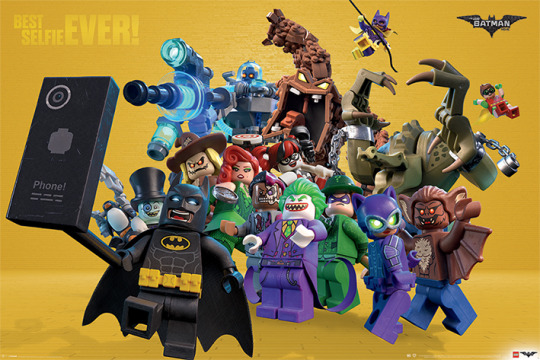
(thanks to The Lego Batman Movie for making my brain keep coming back to this, and also for making such awesome goddamn toys for my retail therapy needs)
While I write my own stories nowadays, the old fanfic writer in me resurfaces every now and then in the form of idle thoughts about how I’d handle certain stories I love. Sometimes these musings lead me to one horrible conclusion: that no matter how much I may love the story in question, I’d be absolutely fuck awful at writing it. This is because the scope of things I’m interested in writing is significantly smaller than the scope of things I’m interested in reading/watching - my muse is a pickier eater than I am.
Still, no matter how awful and off message my bastardized mental versions of these stories may be, they keep popping up now and then, demanding to manifest as stories are wont to do. So today I’m going to exorcise one of them by summarizing it to you.
Today, my wonderful readers, I’m going to tell you how I’d utterly fuck up at writing Batman.
I’m a conditional Batman fan, because there’s a lot of Batman media out there and a lot of it is shit - and also there’s so much of it by volume that even reading/watching only the good Batman stuff would take more time than I can spare. So when I say I love Batman, know that I mean, like, mostly the 90′s animated series and scattered arcs like The Long Halloween that can stand alone, and The Dark Knight, and the Adam West show, and Holy Musical B@man, and some other random Batman stuff. I only know/like some Batman, but the amount of Batman I like is still, like, a lot of Batman. Jesus Christ there’s so much fucking Batman dudes.
But I have some problems with Batman, two of which are relevant to this post because they’re also kind of necessary to its appeal. The first is one that is almost justifiable, although it will undoubtedly sound preposterous to most people: why does Batman have to be so dark?
Don’t get me wrong - I’m a horror fan, so obviously I’m not completely averse to darkness in my fiction. A big part of Batman’s appeal to me comes from how it’s rooted in Gothic Horror tropes. It’s a comic about a dude who dresses up as a Dracula to fight monster men in a city that’s literally called Gotham, so darkness has to be part of the story.
But jeeeeeesus christ Batman is needlessly dark sometimes. Does a bat themed super hero really need to be fighting a guy who carves tally marks into his skin for every person he’s murdered? Is the Joker really more interesting when he’s killing everyone he sees than when he committed clown themed heists? Isn’t being a crocodile man enough intrigue for Killer Croc, or does he need to be a creepy cannibal too? Does every villain need to be a murderer?
While the Adam West Batman show is so campy that I can only tolerate it in small doses, it nonetheless makes me pine for a brighter take on the character/series. It’s kind of nice to have bright colors and jokes and a Batman who doesn’t whine about how sad he is, and villains who are more into making elaborate puzzles and traps instead of finding new ways to mutilate their victims. I’d love to see it blended with the complex psychology of the darker Batmans - but more on that after we get to problem number 2.
Which is, of course, Batman himself.
Batman can be an interesting character. In the best Batman stories, I certainly do love him. But, to be totally honest with you, even at his best, Batman is never the main draw to me in a Batman story. He’s like the bun of a hot dog - it’d be weird to have one without him, and a lot of the more interesting ingredients would sort of fall apart without him holding everything together, and you’d have a great big sticky mess on your hands, but... I mean, if I’m honest, he’s not the part of this I’m looking forward to experiencing. Batman isn’t the meat of the meal to me - no, that role goes instead to his villains.
Goddammit those villains are great! Joker, Two Face, Harley Quinn, Catwoman, Poison Ivy, Mr. Freeze, the Riddler, even the obscure ones like Killer Croc and Clayface, and even the shitty ones like Calendar Man - I just fuckin’ love almost every single one of ‘em, and they’re the reason I keep thinking about how I’d love to just... just utterly ruin Batman.
But when I start thinking of the story I want to tell with those villains, inevitably I remember that, oh hey, I need to have something for Batman to do because, y’know, it’s called Batman for a reason, and my muse just wants nothing to do with that. And that’s why the wheels always fall off.
Well, that and I have a billion other stories to write, but still.
So here’s how I’d ruin Batman in a brief pitch: My Batman story would star the villains, almost none of whom are murderers, in a version of Gotham where Bruce Wayne died with his parents, and thus has no Batman.
You’d have a Gotham City much like the one in Year One (I hate to reference a Frank Miller comic but it’s easily the most well known framework for where I’m starting here), ruled by a mix of slightly exaggerated gangsters and corrupt businessmen - more outlandish in their evil than the real thing but not quite on supervillain level. The villains would all retain their origins for the most part, but without a Batman to draw their focus they sort of turn on each other. It sort of splits into two factions: the Freaks, who are victims/products of the corruption inherent to the city, and the Crimelords, who are the few members of the old/mundane criminal element that adapt to the superpower boom and transition from normal gangsters to supervillains.
The resulting conflict would be the story of a bunch of broken people trying to destroy the system that made them, and the horrible remnants of the old crime world desperately trying to return things to how they are - anarchists vs. tyrants.
Now that we’ve got the basic plot/conflict down, let’s go to what I always focus on first when writing a story: the characters. We’ll begin with our protagonists...
The Freaks
The Joker - obviously the leader of the bunch, the Joker is probably one of the characters I would bastardize/alter the most. Nowadays it’s set pretty firmly in stone that the Joker has to be, like, the most evil man in existence. He’s gotta kill people on a whim, physically abuse his girlfriend, cut off his own face and wear it like a mask, and just generally be a real fuckin’ creep. But does he have to be that evil?
Well yes, yes he does, it’s what makes him iconic and is basically his defining trait, and without it most of the stories told with the character wouldn’t be possible. The idea that he’s the villain who gives other villains nightmares is what makes him stand out. If you lessen the depths of his depravity, you’d ruin Batman.
but does he haaaaaaaaaave to?
Imagine if you will a young, down on his luck commedian named Jack Napier who, in an attempt to provide for his wife, accidentally gets involved with the mob. They make him dress up as a (fictional) crime boss called the Red Hood for a caper - he has to act the part to get the police off the scent of the real bosses. Little does he know that he’s a patsy, set up to not only mislead the police but to buy time for the crooks’ escape by getting into a firefight. He’s shot and falls into some chemicals, gets bleached, and wakes up with a new, much more unhinged state of mind. Like the normal Joker, he finds the magnitude of his tragedy to hilariously absurd. Also like the normal Joker, he decides to become an agent of entropy in hopes of dismantling the city that made him a monster.
Unlike the normal Joker, however, the focus of his wrath isn’t a paragon of morality and justice, but rather the corrupt and powerful rulers of Gotham. He becomes the arch enemy of mobsters, crooked cops, and politicians - people the normal version of the Joker also antagonizes, of course, but not to this level. Since his nemeses are different, this Joker never defines himself as a force of evil and corruption. Instead he humiliates - this Joker punches up and brings those in power down a peg.
The “joke” theme because important here, as the Joker ends up creating a lot of schemes designed to ridicule and embarrass his victims as much as destroy them. It’s not enough to just shoot the corrupt politician - he needs to kill their ego and their sense of power. This Joker would much rather scare the shit out of his victim with a convoluted and frankly stupid “death” trap than just shoot them - and he’d be perfectly content just splatting them in the face with a vaudevillian pie instead of actually killing them at the end.
He wouldn’t be an out and out hero - he doesn’t go out of his way to save people or anything - but he’d also be a far cry from the “killing dozens of people a day for the sake of proving he’s evil” Joker we get nowadays.
He also wouldn’t be aware of the fact that other people don’t necessarily get the joke - not in the malicious “BWAHAHA I’M EVIL AND I’M KILLING YOU WITH LAUGHING GAS IT’S FUNNY TO ME BECAUSE I’M EVIL” way, but in the “Look, I know you’re technically in peril here but you have to admit it’s objectively ridiculous that you’re being dangled above a tank full of piranhas, right? I mean, is it even true that they eat people, or is that a myth? This whole thing’s pretty surreal right?” sort of way.
Harley Quinn - Harley is my favorite Batman character when she’s written well, but sadly she’s normally written absolutely horribly so I’m kind of happy to just fuckin’ ruin this story for her sake. Part of her problem is that the core concept for her character is “psychiatrist is seduced by patient, subjected to psychological and physical abuse by him, and because of said abuse becomes a supervillain.” I mean, a lot of Batman villains also have the “horrible psychological problems make people evil” thing going on which is, y’know, horribly unfortunate, but I feel like Harley’s hit harder than most.
But since the Joker isn’t nearly as much of a bastard in this story, maybe Harley can get out with a nicer origin as well?
This version of Harley isn’t the Joker’s victim so much as a collaborator - maybe the Robin to his Batman? They’re kindred spirits in their love of whimsy and their distaste for how the city is run - Harley in particular has a focus on the corrupt nature of the mental health facility she works at (I mean, Arkham’s not particularly good at its purpose even in the normal Batman universe). Like Robin, Harley softens the Joker’s war on Gotham’s criminal underworld a bit - she drags him into a more compassionate viewpoint. Unlike Robin, she’s not a subordinate/ward - while Harley plays on the Joker’s clown motiff, she doesn’t follow his schemes without question, and always argues for a different way of doing things when the Joker’s plans get too mean-spirited. They’re actual partners in crime, as opposed to the victim/abuser dynamic they had in past fiction.
I realize this is the kind of alteration to canon - y’know, making the main villain sympathetic and a canonically abusive relationship into a healthy romanticized one - that makes people use the word “fanfic” as a pejorative, but, well, I did say this is how I’d ruin Batman.
Catwoman - while the Joker is obviously going to be the leader of the bunch, Catwoman would be the deuteragonist, both because she’s just as iconic and also because she’s probably the closest thing to Batman in this world, and it is still ultimately a world designed to work around a Batman-ish character. Born poor, Catwoman pickpockets her way into wealth, specifically targeting the most corrupt of the wealthy. Unlike most of the other Freaks, she has the option of living a normal life, but is ultimately compelled to keep robbing from the rich and giving to the poor (and also herself - look, she has a lot of cats to feed). Catwoman grounds the Freaks in reality and helps them understand the rules of the system they’re trying to break - and, with her status as an up and coming socialite, is able to give them valuable intel on some of their targets.
Mr. Freeze - honestly you could just transplant the Batman: The Animated Series take on him right into here, because it’s kind of baffling he was considered a villain in the first place. It takes literally no effort to make him a heroic figure - you just have to remove the more-traditionally-heroic Batman to make him shine. Mr. Freeze isn’t as daffy and volatile as the Joker, but is every bit as determined to bring Gotham crashing down and to make the corrupt pay for their cruelty toward people like him. He’s also hilariously serious, providing a stoic counterpoint to the more flamboyant personalities of the other villains.
Poison Ivy - Poison Ivy’s motivation has been “protect the environment, plants specifically”, which is pretty noble to be honest - it’s just that her methods are unnecessarily homicidal. So, y’know, maybe tone that down a bit? Less “mind controlling innocent people and murdering them for money to build a plant park” and more “using convenient giant animate plants to halt construction that threatens local parks” sort of schemes. She’d basically be an environmental sciences themed vigilante - Captain Planet with an aggressive streak.
I know it’s more traditional to pair her with Harley Quinn, but I’d kinda like to try setting her up with Catwoman instead - both of them has this history of being femme fatales/evil seducers of men, so it’d be kind of fun to have a story where they just have none of that at all. Though pairing her with Harley and making the Harley/Joker relationship purely platonic is an interesting dynamic too...
Killer Croc - he’s a great big crocodile man who lives in the sewers because no one above ground accepts him, on account of him being a big crocodile man and all. Despite his fearsome appearance and prodigious strength, he’s a pretty swell guy - the gentle bruiser of the group.
Two-Face - like Mr. Freeze, you really don’t have to alter much to make him a good guy. Just keep Two-Face pointed at mobsters and he works as a hero pretty well.
The Riddler - In this world, the Riddler begins as a cop who, while clever, isn’t corrupt enough to excel in the police department. His superiors assign him to the Freak case in hopes of getting rid of him (preferably in a fatal sort of way), but that plan succeeds in the worst way, as he ends up defecting to their side. The Riddler helps the Freaks make their schemes truly bizarre and unpredictable, and helps them get to the bottom of who is truly running Gotham City. He’s also a smug prick about it, because smugness is key to his character.
Clayface - a star of Gotham’s theater scene, Basil Karlo is convinced to try an experiment age-defying makeup which turns him into a giant shape changing mud man. He becomes the group’s master of disguise and also ups their general theatricality, and can back up Croc as the muscle in a pinch.
The Crimelords
Penguin - a petty thug with delusions of grandeur, Penguin wants to rise to the ranks of the social elite and goes to great lengths to seem more educated and “classy” than he is. While he is never accepted by the rich people he idolizes, he continues to do their dirty work in hopes of getting their approval. He is cunning in a way, though, and rises to prominence throughout the story as one of the few criminals who can keep up with the increasingly eccentric Freaks - probably because he’s basically one of them despite his protests.
Scarecrow - a corrupt psychologist at Arkham Asylum who helps the mafia by providing insanity defenses for mobsters and driving key witnesses insane, Scarecrow’s obsession with fear would spiral out of control throughout the story. Eventually he’d switch sides to the Freaks when he gets too weird for the oldschool criminals to tolerate, although he’d never be well liked by either side.
Firefly - a particularly skilled arsonist for the Maroni crime family. Not much more than that.
Deathstroke - the greatest assassin employed by the Falcone crime family, Deathstroke takes himself very seriously, which is to his detriment considering the pack of ridiculous monster men he’s facing in this story. He has a bitter rivalry with...
Deadshot - the greatest assassin employed by the Maroni crime family. Deadshot doesn’t take his work very seriously at all and is prone to sarcasm and flippancy. He kind of loves the fact that the freaks are causing so much ridiculous trouble for his employers, but that doesn’t mean he won’t kill them for a paycheck.
Bane - a mercenary hired by the crime families to take down the Freaks. Bane eventually switches sides; he may be a bad guy, but he also cares about the downtrodden having grown up in a city not unlike Gotham itself.
Calendar Man - the youngest son of the mafia boss Carmine Falcone, Alberto Falcone is inspired by the theatricality of the Freaks and becomes a holiday themed serial killer, targeting enemies of his father’s business in a misguided attempt to earn his approval.
Black Mask - As the different crime families slowly dwindle in number over the course of the story, Roland Sionis, an underboss for the Maroni family, eventually rises in the ranks (due to his superiors dying) and unites what remains of the mafia under his iron fist. Deciding to fight fire with fire, he crafts a grim alter ego for himself in hopes of striking fear into the Freaks. It doesn’t work because he’s just not theatrical enough to pull it off, but he does manage to be a thorn in their side for a while.
Hugo Strange - the chief psychologist of Arkham Asylum, Hugo Strange is an awful, awful man. He’s also an incredibly intelligent one, master minding many of the problems the Freaks encounter. He’s not the root of Gotham’s problems, though, as he ultimately serves...
Ra’s Al Ghul - an ancient sorceror who has made and destroyed countless societies in his many centuries of scheming, Ra’s Al Ghul made Gotham City into a nexus of misery and cruelty in hopes of awakening a world ruining entity - i.e. basically he’s trying to bring about Gozer the Destroyer. ‘Cause why not bring in a bit of Lovecraftian terror to a setting that has a madhouse that makes monster people that’s literally called Arkham Asylum?
And that’s it. That’s how I’d ruin Batman.
I’ll probably repurpose some of these ideas into other stories like I do with most of my fanfic ideas, but man, this sure is shitty as a Batman story, huh?
107 notes
·
View notes
Text
This slideshow requires JavaScript.
Batman #27
One man finds himself caught between the forces of the War of the Jokes and Riddles like a kite in a hurricane, being pushed and pulled between Joker, Riddler, and Batman; and his family’s safety hanging in the balance.
There’s been one character that’s popped up randomly but reliably since King started his run on Batman, and he finally gets an issue (at least one issue) all to himself. Ironically, King is using his focus on this character to give us a ground level perspective on the war, what it’s like to be a small time criminal with some notable skills in the middle of one of the most tumultuous times in Gotham’s history. It’s not only the opportunity to give pathos to someone who’s been a joke up until now, but in that pathos, we better understand the toll this war pays on even the D-listers of the city. And, of course, King handles it with the same poetry he’s handled the rest of the series, showing us the seeds of a flower that’s already bloomed.
Superman #27
It’s time for a Kent family vacation, and for the Independence Day (this comic is a wee bit late), they’re going on a tour of American memorials, with Clark and Lois teaching Jon about the history that makes them worth the trip.
I’m a fan of hokey and schmaltzy, but patriotic schmaltz is where I draw the line. After all, there’s history and there’s hierography, and it’s hard for me to tolerate any account of, for example, the founders, without bringing up their hypocrisies of slave ownership and genocide. Plus, there’s the general glorification of war that happens whenever you do this type of thing that sours even sweet scenes like the Kents treating a hopeless vet to dinner and standing up for his right to dine somewhere even if he may “disturb other customers.”
Superman is meant, in part, to represent the best of American ideals, and unfortunately, this comic doesn’t really touch those.
Green Arrow #27
Here, however, is a comic that discusses America in a way I can get behind.
Green Arrow’s search for the Ninth Circle takes him to Washington DC, where he runs into Wonder Woman, and the two foil a plot to increase America’s support of war, and thus military spending.
Green Arrow doesn’t even try for subtlety here, at times reading like a polemic against America’s hawkishness – which is incredible. Oliver waxes on about how the Ninth Circle uses fear to motivate people to their side by convincing the public that the only way to feel safe is to buy more and more weapons to protect them from an increasingly dangerous threat – a threat they engineer, of course. He even lectures about himself and his own ignorance of his privilege when he first began as the Green Arrow.
But what’s so effective is that, despite how over the top things get in this comic, the results are all too familiar. A formally pro-peace senator being scared into supporting increased “defense.” Despite saving the day, Oliver and the comic believe that, regardless of political affiliation, all politicians are motivated by fear and eventually learn to support endless war for the sake of feeling secure. It’s all lies acted on for the sake of profit.
The Wild Storm #6
We’re 25% through this story, which, in Ellis time, means that it’s finally appropriate time for an infodump.
After an expertly scripted and executed fight scene, that reads like John Wick fighting Jaws from 007, between Cray and the two-person kill-squad sent to kill him ends with Cray accepting Christine Trelane’s job offer – Adrianna brings Spica to Jake Marlowe’s base in Brooklyn so she (and we) can get some questions answered about IO, Skywatch, and how this world is run.
The way the comic is put together, the fight in the beginning feels like having your dessert before your dinner; quenching our action-tooth before giving us some nourishing exposition. But I don’t want to give the impression that this is dry exposition. Ellis still writes some of the sharpest dialogue in comics (and TV and film), and Davis-Hunt still finds ways to make two people talking at a table graphically disturbing when certain reveals make it appropriate. Between this and Clean Room, he’s become my favorite comic artist for scenes of the grotesque and Giger-esque.
Secret Empire #6
While lost-Steve continues to be tortured by the Red Skull, and the heroes trapped in the Darkforce dimension do their best to keep Tandy’s light; Hydra unleashes a full-on assault on the resistance base. And inside their crumbling base, the resistance tears themselves apart trying to find their mole.
This issue is all over the place, not giving any of its developments any time to breathe. I’m not sure if this issue is supposed to end on a high-point or low-point, and I doubt that’s intentional. Through the issue is a narration that starts with Steve talking about how all heroes are hypocrites who fight only for their own pride and reputation, then goes to Hawkeye during the attack on the Mount where he seems to admit defeat before being reminded of why heroes really fight. And there’s a dramatic showdown between Steve and Tony that intentionally echoes the first Civil War. Hydra unleashes the Hulk on the resistance in what feels like it’s supposed to be the story’s lowest point, but this is right about the point in the story where Hawkeye’s narration tells us that this is where all the heroes regain their nerve…and then there’s a nuke and we’re supposed to believe everyone died even though we saw them all escape…?
Again, nothing has room to actually land and breathe before the issue hits us over the head with the next dramatic moment. While I’m normally against extending these events at all – and this one is already set to be 10 issues – this issue could’ve easily been split into two that allow for a better dramatic arc to unfold over the course of this one battle.
Peter Parker: The Spectacular Spider-Man #2
After a brief misunderstanding with Ironheart, who eventually agrees to help Peter with the hacked Stark phone, Pete heads back to New York to summarize Amazing Spider-Man: Family Business to a confused Johnny Storm, and then go on his date with Rebecca…in full costume.
Like Zdarksy’s other books with Marvel, this one slows down and takes us more towards the ground-level with its characters, putting more focus on their day-to-day rather than whatever big criminal plot they’re gonna have to face. We spend a lot more time with Peter in his apartment chatting with Teresa and Johnny, or out on his date than we do following up on the hacked phone.
And Zdarksy writes the most natural sounding Peter dialogue in any Spider-Man comic today. Where Bendis’ writing can often feel like the characters are reading from a script, and many of Slott’s quips feel (appropriately) forced; Zdarsky’s Peter reads like someone legitimately saying the first funny thing that pops into his head, and is appropriately hit-and-miss. That feeling is also aided by the more normal situations that Peter’s found himself in this issue; as he’s quipping during a date, not while fighting supervillains.
I think, more than not mentioning his current status quo as a billionaire, the reason that this series feels like a return to form is because it’s focusing a lot more on Peter than Spider-Man.
Ms. Marvel #20
In this issue’s opening pages, Ms. Marvel establishes itself as the ideal of “the world outside your window” that all Marvel comics that choose to attempt that should strive towards. Aamir, who was arrested for no reason last issue, pleads his case explaining his innocence, and even explains who the authorities should look for if they want to find terrorists that look like him. It’s an eloquent and grounded explanation of who gets radicalized and why, delivered by a character in a situation that reflects our unfortunate reality. It’s a clear-headed and powerful scene, and more comics should strive for such relevancy.
Then, Ms. Marvel wakes up from being knocked-out last issue, and jumping back into action, finds herself in the middle of a Chuck Worthy rally. Worthy’s speech is reflective of the sort of conservative rhetoric of law and order and nostalgia that unfortunately wins elections; but presents it in a way that doesn’t necessarily hit you over the head with it, like a comic like Green Arrow would.
This arc – and this series overall – successfully puts it’s hero against clear analogues for real world issues, and makes them approachable and resonant. Yeah, you’re getting a story about a stretchy girl that punches bad robots, but Ms. Marvel has also told stories about gentrification, online-harassment, and islamophobia that confront each issue with the same tenacity that Kamala confronts her villains.
Bitch Planet: Triple Feature #2
And where Ms. Marvel tackles real world issues with a degree of allegory, Bitch Planet has always come at it from the angle of parody – ramping up the real world effects of white patriarchy to what are supposed to be ridiculous extremities. Like the last triple feature, this issue takes us off the prison planet and to Earth itself, where life isn’t that much better for women.
The first story, Bits and Pieces, shows us a child’s beauty pageant in Bitch Planet, where tween girls are judged on the beauty of a single body part, and has one heck of a final page. The second, This is Good for You, shows us a propaganda film. And the third and longest story, What’s Love Got to do With it?, tells the story of one woman’s quest to get married before her family is forced to pay an “Old Maid tax,” and explores how dating is done on Bitch Planet.
All of these stories are generally funnier than the main series, each acting as a short parody of a single aspect of what living in an uber-patriarchy would be that rather than telling the sort of wide-ranging story of the main title. This means that each story is also sharper, with single page conclusions finding inventive ways to twist the knife like the best episodes of The Twilight Zone.
Comic Reviews for 7/19/17 Batman #27 One man finds himself caught between the forces of the War of the Jokes and Riddles like a kite in a hurricane, being pushed and pulled between Joker, Riddler, and Batman; and his family's safety hanging in the balance.
#batman#bitch planet#dc comics#green arrow#marvel#ms. marvel#peter parker#secret empire#spider-man#superman#triple feature#wild storm
0 notes
Text
New Earth Orca’s Death in Batman: Face The Face (And Why It Was Stupid, Gross and Pointless)
Warning: This post covers part of a comic storyline that contains graphic depictions of gore and blood. I will be putting it under the cut for those who are sensitive to this subject matter, as well as for length.
Batman: Face The Face was a storyline that concerned a serial killer killing off C list villains, with evidence seeming to point to a supposedly reformed Harvey Dent, who at the time had been serving as one of Gotham’s protectors, sanctioned by Batman in the wake of his absence during the No Man’s Land story arc. Batman and the Tim Drake Robin had returned to Gotham to find that old enemies Magpie, KGBeast and the Ventriloquist had all been murdered. Batman sent private detective and old ally Jason Bard to continue investigating during the daylight hours. Batman soon discovered that each of the villains had been slain by two shots to the head from a specialized gun that belonged to Harvey Dent. He also learned that the villains had all been working for the Penguin and that they had had a secret meeting with Harvey prior to their deaths. While investigating the crime scene of the Ventriloquist’s murder, he discovered that the dying man had left a clue, finding the name of a street. Following up on the lead, Robin found surveillance footage from the area showing the clandestine meeting between Harvey and the now-dead villains, with the revelation that there was a fourth villain in Penguin’s employ: Orca.
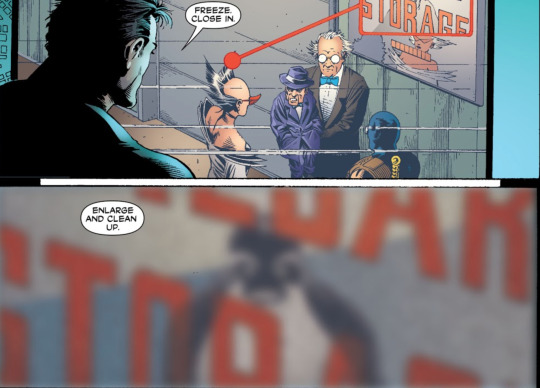
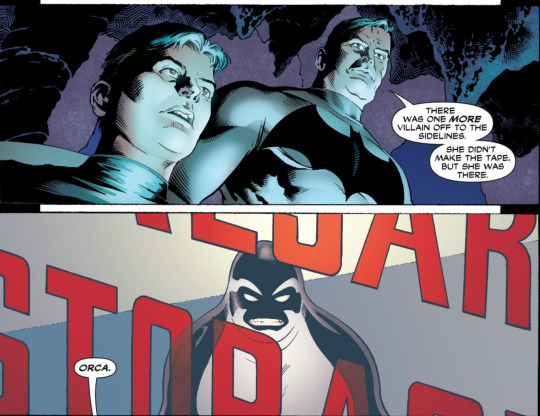
While Batman and Robin worked with a police team under Gordon and Bullock, the murder weapon was soon found with Harvey Dent’s prints on it, leading Batman to confront Harvey in his penthouse. With Batman practically accusing Harvey of being the murderer, Harvey lashed out verbally before blowing up the penthouse, with both he and Batman escaping separately. On another night, Batman and Robin headed into Gotham’s sewer ways to try to find Orca, hoping to save her before she met the same fate as the other villains. They encountered Killer Croc and had a brief battle with him, with Batman using a flash grenade to blind him long enough to knock him out with a small explosive. Not long after, they found the mutilated corpse of Orca, having been partially eaten by Killer Croc. Closer inspection of the body revealed that Orca had been dead prior to her corpse being eaten, killed by the same tell-tale two bullets to the head as the other victims.
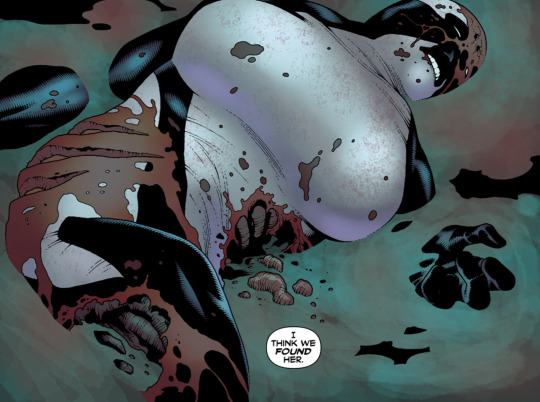
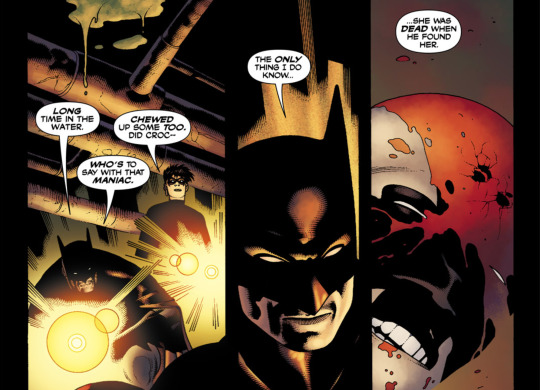
In the meantime, Jason Bard had been digging into Orca’s personal life, discovering that she had gotten married within the last year. Jason went to speak to her husband Terry Capshaw, unaware that Orca’s body had been found. Terry revealed that Orca had been missing for a week, how he and she first met and most importantly, that she had regularly held meetings with other lesser known villains in their home, including the others who worked for Penguin. When pressed by Jason, Terry revealed that Orca and the others planned to steal a cache of weapons from a storage facility owned by the Penguin, having been recruited to change sides by someone making a play for control of Gotham’s underworld. However, Harvey Dent arrived just as the heist was about to take place, convincing the group to stick with Penguin in order to act as Dent’s spies, threatening to expose their turncoat actions if they refused.
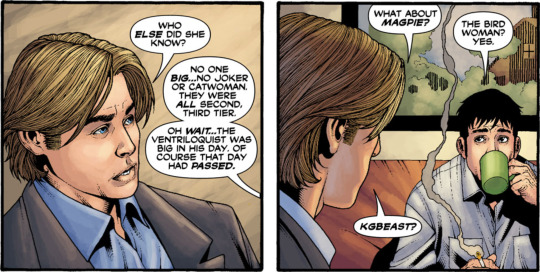
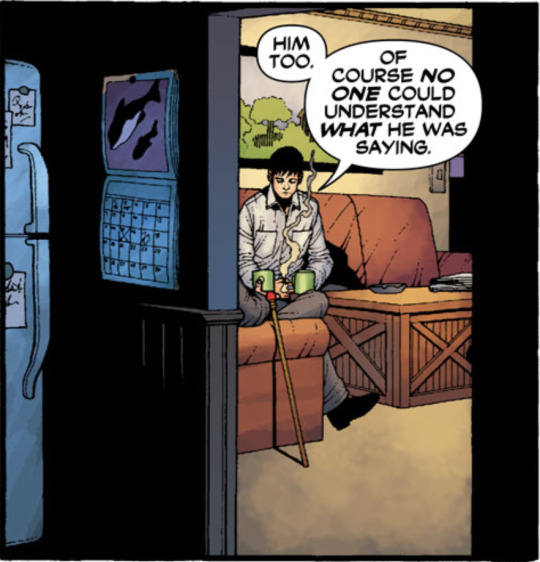
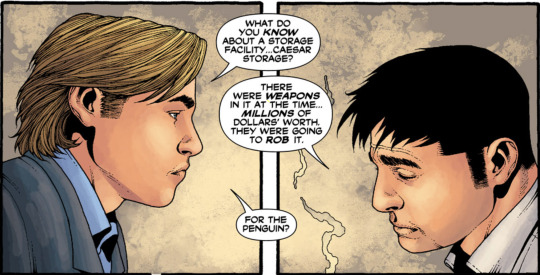
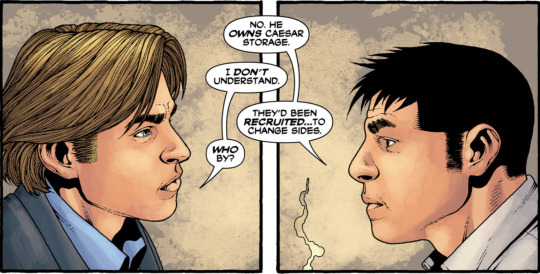

Just as Terry began talking about hearing a name referencing sea life, Jason spotted the laser sight of a gun aimed at Terry’s head. Frozen in sudden panic, Jason was unable to prevent Terry’s assassination. Jason was soon shot himself as the real serial killer revealed himself: the latest holder of the Tally Man moniker.

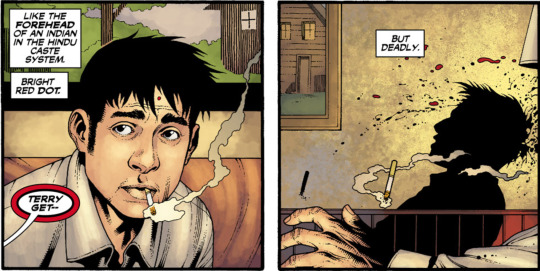
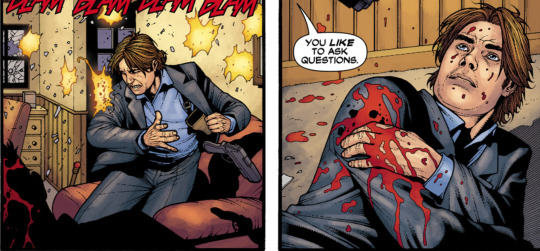
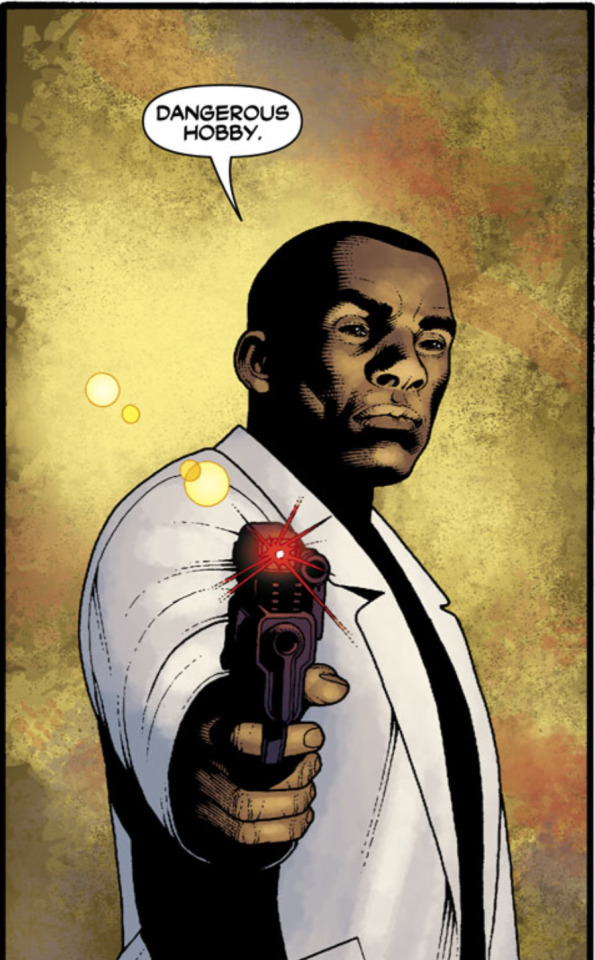
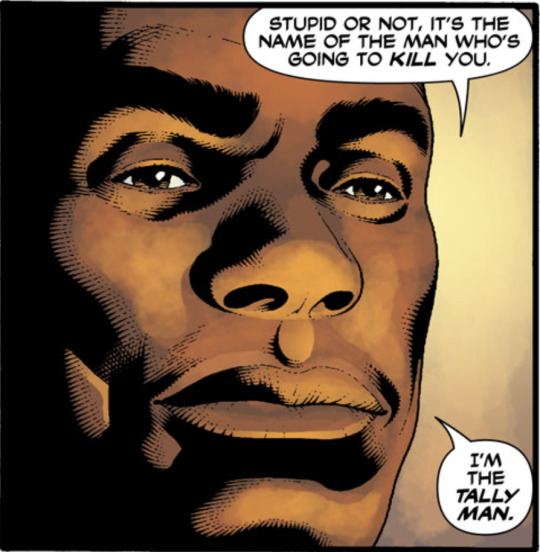
Despite his injuries, Jason managed to use his cane to knock the Tally Man off balance, shooting his hand to prevent him using his gun again before finally knocking him out during the ensuing brawl.
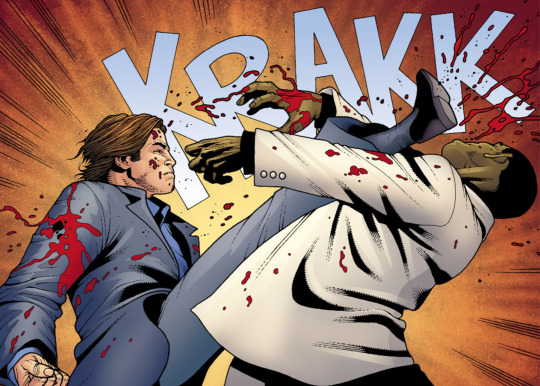
Jason then called Batman to inform him that Orca’s husband had been assassinated and that he had found/incapacitated the real killer. Unfortunately by this time, under the pressure of the framing and accusations, Harvey Dent had given in to his demons and once again become Two-Face. His threat to blow up a zoo forced Batman to go after him, with Two-Face ultimately escaping the confrontation and rightfully blaming Batman for his lack of faith in Harvey. Batman later discovered the final piece of the puzzle from the information Jason gathered: the sea life related name Terry had mentioned before his death was none other than the crime boss Warren White, the villain know as the Great White Shark. He had masterminded the whole plot: hiring the Tally Man to kill the villains working for Penguin in order to weaken his rival’s power, while framing Harvey Dent for the crimes. Unfortunately, Batman was unable to prove the Great White Shark’s involvement in the murders, but promised White that he would inform Two-Face about what had been done.
Notes: I hate this storyline. Both Orca and Terry deserved better ends than they got. Not just because I like them, but also just because their deaths were so nasty for something so petty as a power grab. The fact that Orca’s body was chewed up by Killer Croc for no reason other than shock value and that an artist had to render it in detail was just tasteless in the context of the story, as was showing Terry’s corpse. I didn’t show that panel because it wasn’t plot relevant, so it would’ve just been gratuitous. About the only thing of note about this storyline, outside of Harvey Dent becoming Two-Face again, was that all the C-list villains killed during this storyline remained dead and while the Ventriloquist, KGBeast and Magpie’s corpses later became Black Lanterns during the Blackest Night story arc, Orca did not. New incarnations of the characters wouldn’t show up in mainline titles until the New 52 and DC Rebirth reboots. No other versions of Terry Capshaw have appeared, with both the Prime Earth and Injustice versions of Orca only seeming to acknowledge the initial storyline of her first appearance in their backgrounds.
For further reasons why this storyline sucks, I suggest reading this in-depth review: https://about-faces.livejournal.com/43785.html
So there you have it, now you know why I chose to ignore everything about this storyline outside of Terry Capshaw. Terry gets to live in my main verse and only dies in my Injustice verse because characters are constantly dying in horrible ways in that universe, so it makes sense for him to have a tragic end in that context.
#Landlubber (OOC)#Apex Predator (Muse Images)#Whalelore (About The Muse)#batman face the face#batman#detective comics#trigger gore#trigger blood#about-faces#The Typhon to My Echidna (Waylon)#She Liked Nerds (Terry Capshaw)#Man in Bat's Clothing (Batman)#Turdidae (Robins)#Gumshoe (Jason Bard)#Pica (Magpie)#Double Talk (Ventriloquist)#The Assassin Who Came In From The Cold (KGBeast)#Fractured Soul (Harvey Dent/Two-Face)#Small Fry (Great White Shark)#Blood Debt (Tally Man)
1 note
·
View note
Text
This slideshow requires JavaScript.
Batman #27
One man finds himself caught between the forces of the War of the Jokes and Riddles like a kite in a hurricane, being pushed and pulled between Joker, Riddler, and Batman; and his family’s safety hanging in the balance.
There’s been one character that’s popped up randomly but reliably since King started his run on Batman, and he finally gets an issue (at least one issue) all to himself. Ironically, King is using his focus on this character to give us a ground level perspective on the war, what it’s like to be a small time criminal with some notable skills in the middle of one of the most tumultuous times in Gotham’s history. It’s not only the opportunity to give pathos to someone who’s been a joke up until now, but in that pathos, we better understand the toll this war pays on even the D-listers of the city. And, of course, King handles it with the same poetry he’s handled the rest of the series, showing us the seeds of a flower that’s already bloomed.
Superman #27
It’s time for a Kent family vacation, and for the Independence Day (this comic is a wee bit late), they’re going on a tour of American memorials, with Clark and Lois teaching Jon about the history that makes them worth the trip.
I’m a fan of hokey and schmaltzy, but patriotic schmaltz is where I draw the line. After all, there’s history and there’s hierography, and it’s hard for me to tolerate any account of, for example, the founders, without bringing up their hypocrisies of slave ownership and genocide. Plus, there’s the general glorification of war that happens whenever you do this type of thing that sours even sweet scenes like the Kents treating a hopeless vet to dinner and standing up for his right to dine somewhere even if he may “disturb other customers.”
Superman is meant, in part, to represent the best of American ideals, and unfortunately, this comic doesn’t really touch those.
Green Arrow #27
Here, however, is a comic that discusses America in a way I can get behind.
Green Arrow’s search for the Ninth Circle takes him to Washington DC, where he runs into Wonder Woman, and the two foil a plot to increase America’s support of war, and thus military spending.
Green Arrow doesn’t even try for subtlety here, at times reading like a polemic against America’s hawkishness – which is incredible. Oliver waxes on about how the Ninth Circle uses fear to motivate people to their side by convincing the public that the only way to feel safe is to buy more and more weapons to protect them from an increasingly dangerous threat – a threat they engineer, of course. He even lectures about himself and his own ignorance of his privilege when he first began as the Green Arrow.
But what’s so effective is that, despite how over the top things get in this comic, the results are all too familiar. A formally pro-peace senator being scared into supporting increased “defense.” Despite saving the day, Oliver and the comic believe that, regardless of political affiliation, all politicians are motivated by fear and eventually learn to support endless war for the sake of feeling secure. It’s all lies acted on for the sake of profit.
The Wild Storm #6
We’re 25% through this story, which, in Ellis time, means that it’s finally appropriate time for an infodump.
After an expertly scripted and executed fight scene, that reads like John Wick fighting Jaws from 007, between Cray and the two-person kill-squad sent to kill him ends with Cray accepting Christine Trelane’s job offer – Adrianna brings Spica to Jake Marlowe’s base in Brooklyn so she (and we) can get some questions answered about IO, Skywatch, and how this world is run.
The way the comic is put together, the fight in the beginning feels like having your dessert before your dinner; quenching our action-tooth before giving us some nourishing exposition. But I don’t want to give the impression that this is dry exposition. Ellis still writes some of the sharpest dialogue in comics (and TV and film), and Davis-Hunt still finds ways to make two people talking at a table graphically disturbing when certain reveals make it appropriate. Between this and Clean Room, he’s become my favorite comic artist for scenes of the grotesque and Giger-esque.
Secret Empire #6
While lost-Steve continues to be tortured by the Red Skull, and the heroes trapped in the Darkforce dimension do their best to keep Tandy’s light; Hydra unleashes a full-on assault on the resistance base. And inside their crumbling base, the resistance tears themselves apart trying to find their mole.
This issue is all over the place, not giving any of its developments any time to breathe. I’m not sure if this issue is supposed to end on a high-point or low-point, and I doubt that’s intentional. Through the issue is a narration that starts with Steve talking about how all heroes are hypocrites who fight only for their own pride and reputation, then goes to Hawkeye during the attack on the Mount where he seems to admit defeat before being reminded of why heroes really fight. And there’s a dramatic showdown between Steve and Tony that intentionally echoes the first Civil War. Hydra unleashes the Hulk on the resistance in what feels like it’s supposed to be the story’s lowest point, but this is right about the point in the story where Hawkeye’s narration tells us that this is where all the heroes regain their nerve…and then there’s a nuke and we’re supposed to believe everyone died even though we saw them all escape…?
Again, nothing has room to actually land and breathe before the issue hits us over the head with the next dramatic moment. While I’m normally against extending these events at all – and this one is already set to be 10 issues – this issue could’ve easily been split into two that allow for a better dramatic arc to unfold over the course of this one battle.
Peter Parker: The Spectacular Spider-Man #2
After a brief misunderstanding with Ironheart, who eventually agrees to help Peter with the hacked Stark phone, Pete heads back to New York to summarize Amazing Spider-Man: Family Business to a confused Johnny Storm, and then go on his date with Rebecca…in full costume.
Like Zdarksy’s other books with Marvel, this one slows down and takes us more towards the ground-level with its characters, putting more focus on their day-to-day rather than whatever big criminal plot they’re gonna have to face. We spend a lot more time with Peter in his apartment chatting with Teresa and Johnny, or out on his date than we do following up on the hacked phone.
And Zdarksy writes the most natural sounding Peter dialogue in any Spider-Man comic today. Where Bendis’ writing can often feel like the characters are reading from a script, and many of Slott’s quips feel (appropriately) forced; Zdarsky’s Peter reads like someone legitimately saying the first funny thing that pops into his head, and is appropriately hit-and-miss. That feeling is also aided by the more normal situations that Peter’s found himself in this issue; as he’s quipping during a date, not while fighting supervillains.
I think, more than not mentioning his current status quo as a billionaire, the reason that this series feels like a return to form is because it’s focusing a lot more on Peter than Spider-Man.
Ms. Marvel #20
In this issue’s opening pages, Ms. Marvel establishes itself as the ideal of “the world outside your window” that all Marvel comics that choose to attempt that should strive towards. Aamir, who was arrested for no reason last issue, pleads his case explaining his innocence, and even explains who the authorities should look for if they want to find terrorists that look like him. It’s an eloquent and grounded explanation of who gets radicalized and why, delivered by a character in a situation that reflects our unfortunate reality. It’s a clear-headed and powerful scene, and more comics should strive for such relevancy.
Then, Ms. Marvel wakes up from being knocked-out last issue, and jumping back into action, finds herself in the middle of a Chuck Worthy rally. Worthy’s speech is reflective of the sort of conservative rhetoric of law and order and nostalgia that unfortunately wins elections; but presents it in a way that doesn’t necessarily hit you over the head with it, like a comic like Green Arrow would.
This arc – and this series overall – successfully puts it’s hero against clear analogues for real world issues, and makes them approachable and resonant. Yeah, you’re getting a story about a stretchy girl that punches bad robots, but Ms. Marvel has also told stories about gentrification, online-harassment, and islamophobia that confront each issue with the same tenacity that Kamala confronts her villains.
Bitch Planet: Triple Feature #2
And where Ms. Marvel tackles real world issues with a degree of allegory, Bitch Planet has always come at it from the angle of parody – ramping up the real world effects of white patriarchy to what are supposed to be ridiculous extremities. Like the last triple feature, this issue takes us off the prison planet and to Earth itself, where life isn’t that much better for women.
The first story, Bits and Pieces, shows us a child’s beauty pageant in Bitch Planet, where tween girls are judged on the beauty of a single body part, and has one heck of a final page. The second, This is Good for You, shows us a propaganda film. And the third and longest story, What’s Love Got to do With it?, tells the story of one woman’s quest to get married before her family is forced to pay an “Old Maid tax,” and explores how dating is done on Bitch Planet.
All of these stories are generally funnier than the main series, each acting as a short parody of a single aspect of what living in an uber-patriarchy would be that rather than telling the sort of wide-ranging story of the main title. This means that each story is also sharper, with single page conclusions finding inventive ways to twist the knife like the best episodes of The Twilight Zone.
Comic Reviews for 7/19/17 Batman #27 One man finds himself caught between the forces of the War of the Jokes and Riddles like a kite in a hurricane, being pushed and pulled between Joker, Riddler, and Batman; and his family's safety hanging in the balance.
#batman#bitch planet#dc comics#green arrow#marvel#ms. marvel#peter parker#secret empire#spider-man#superman#triple feature#wild storm
0 notes